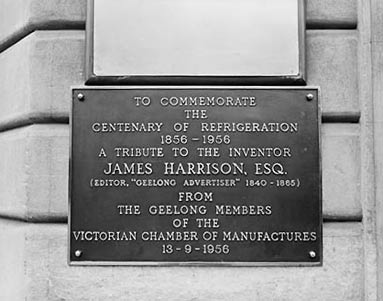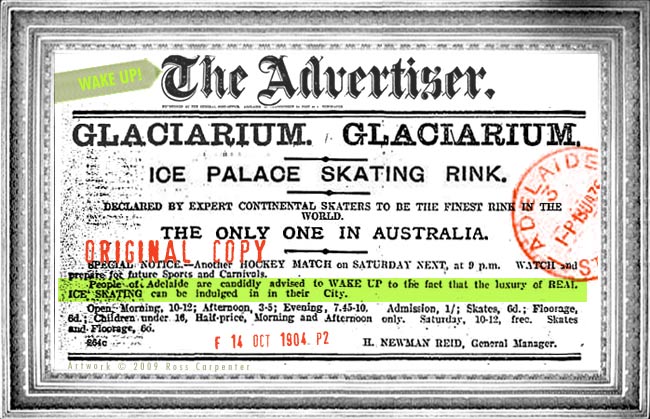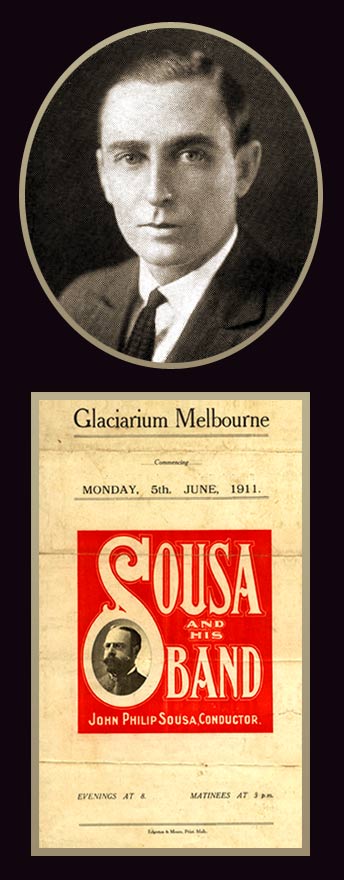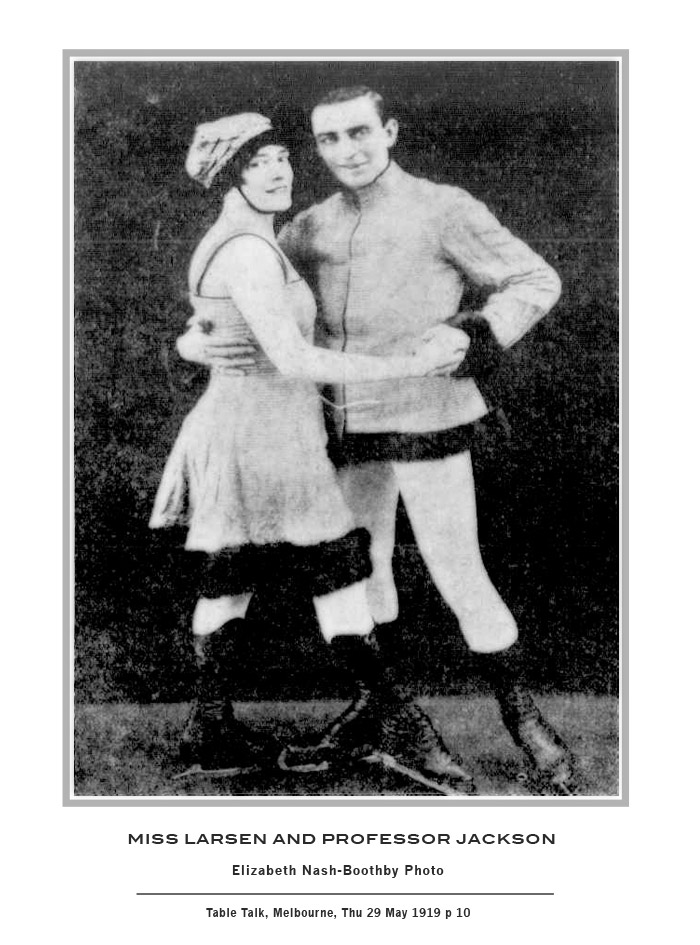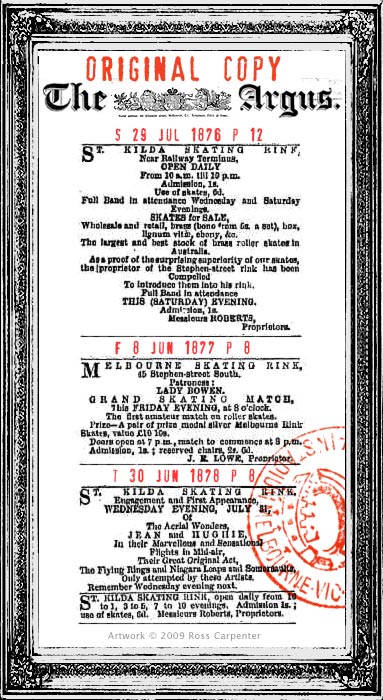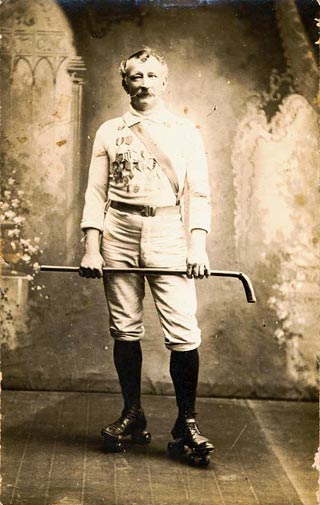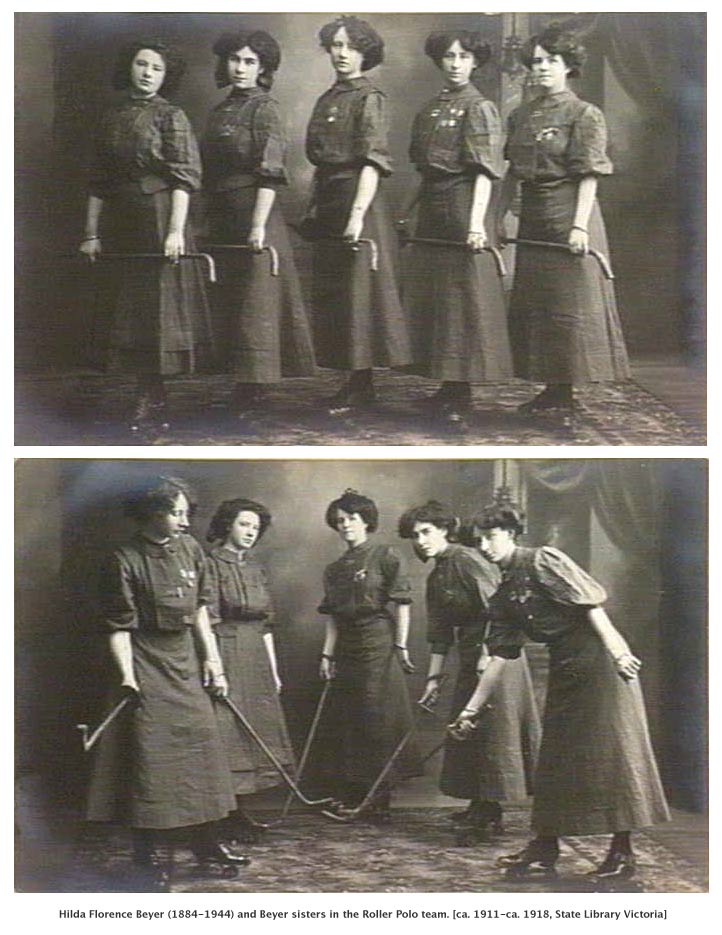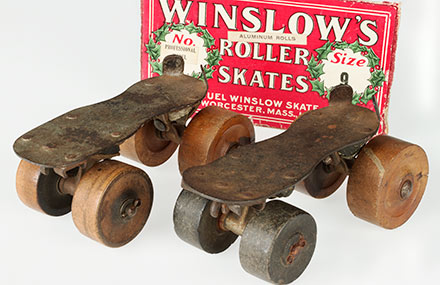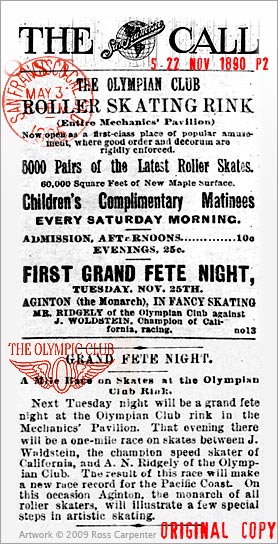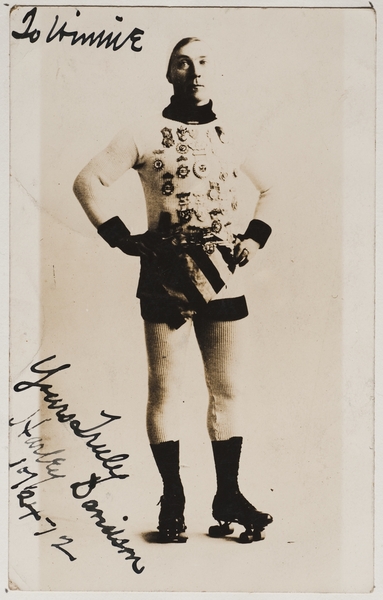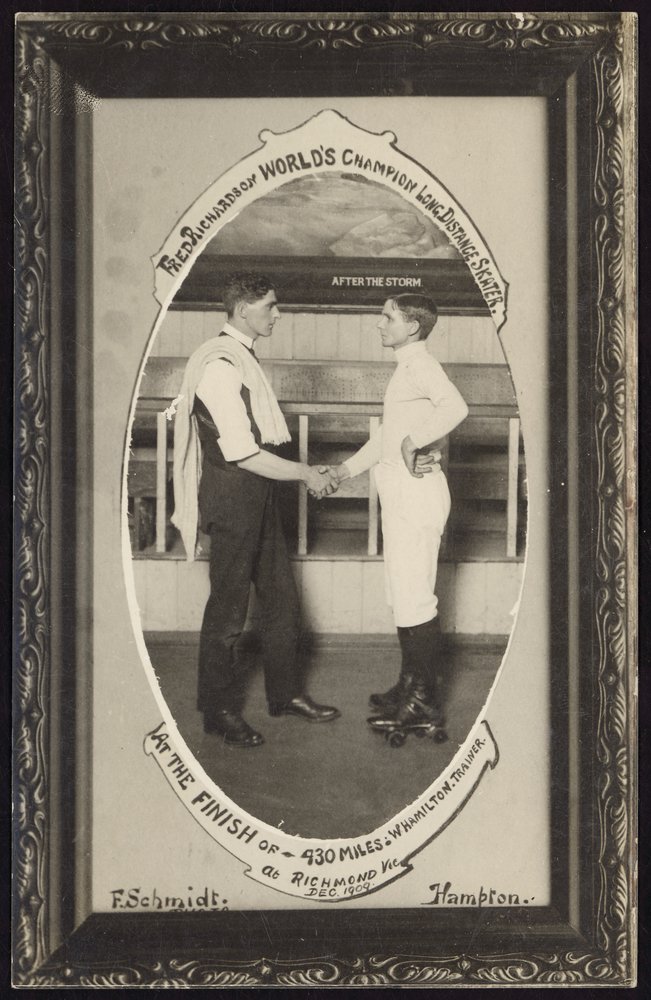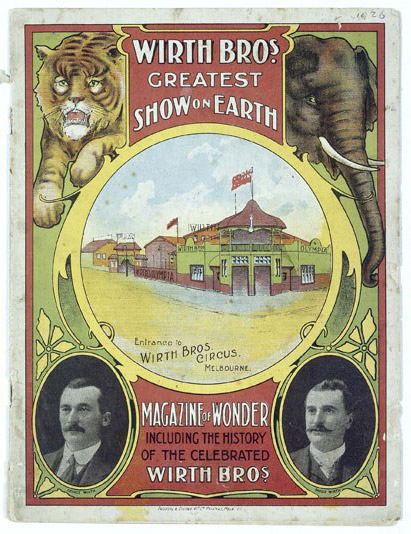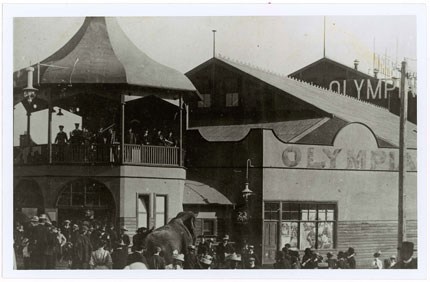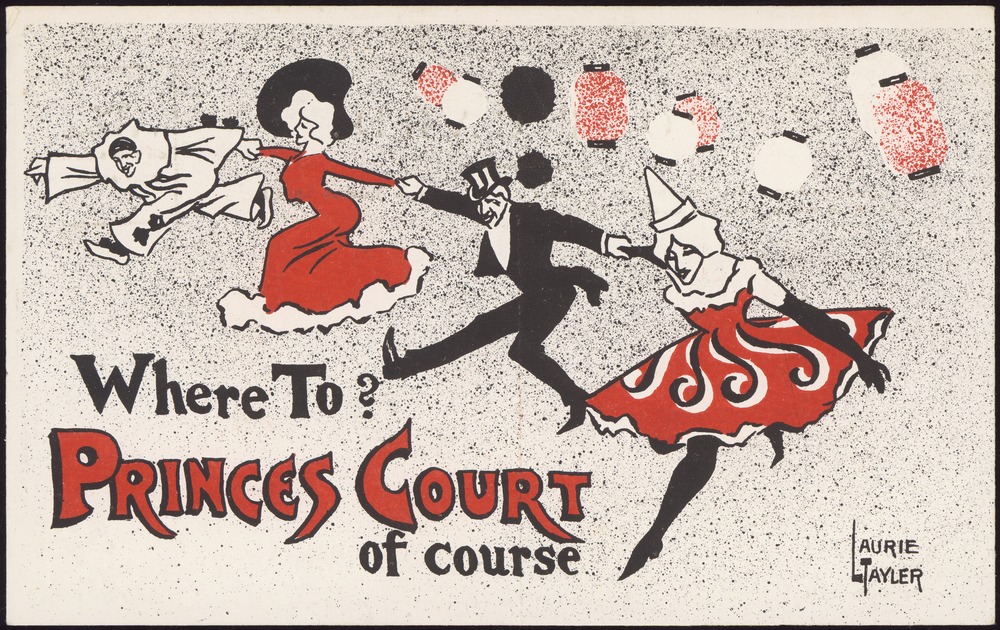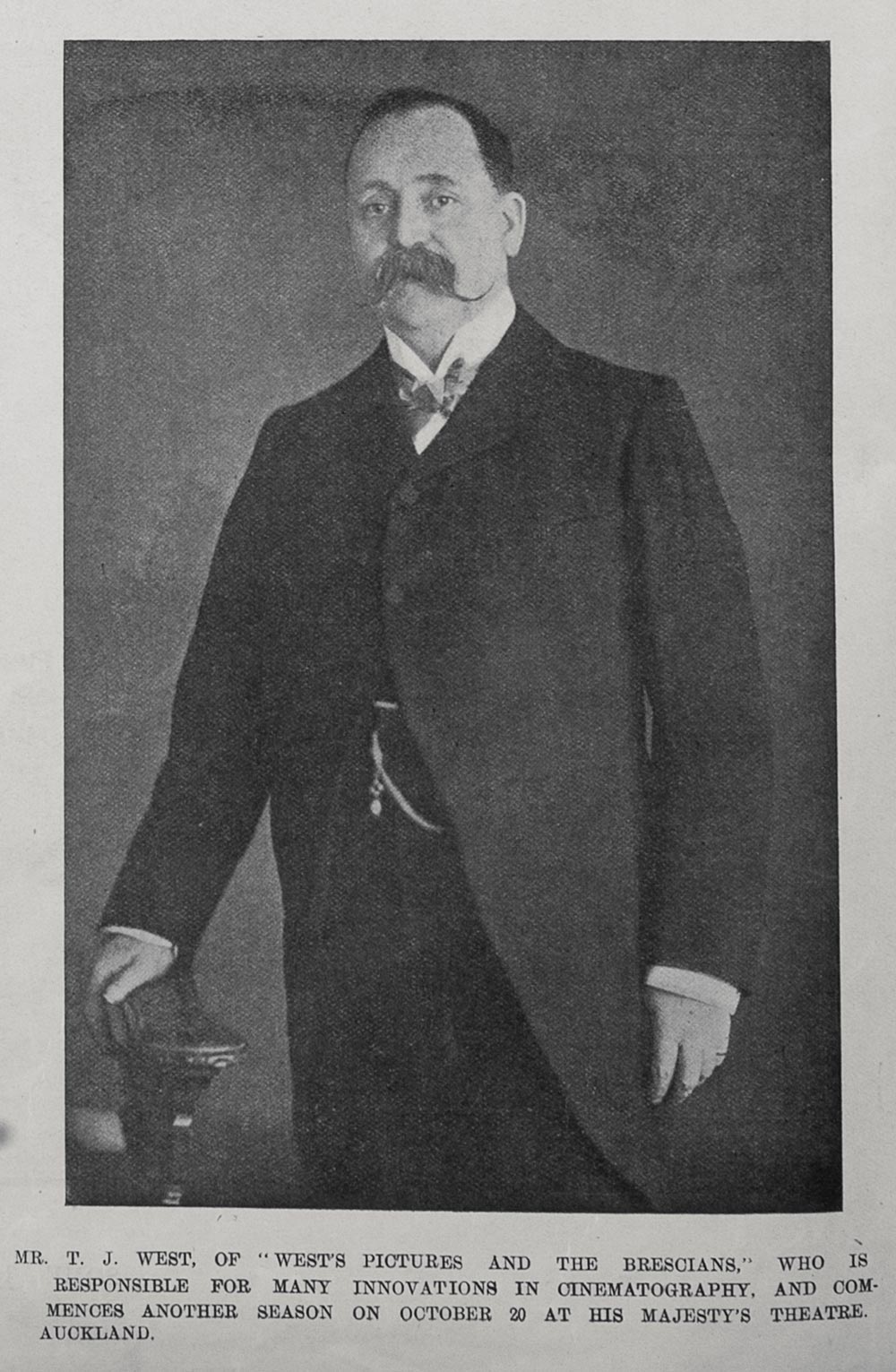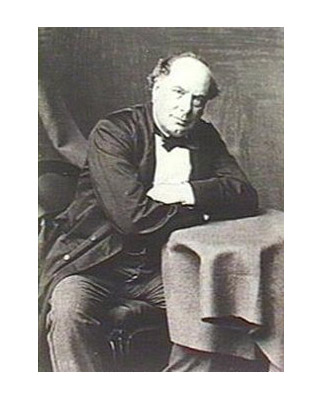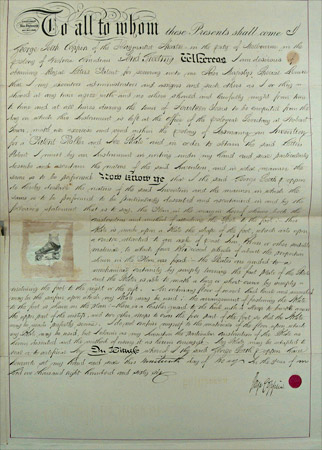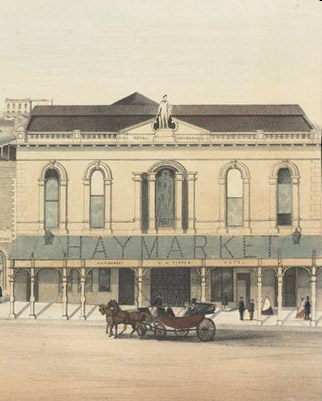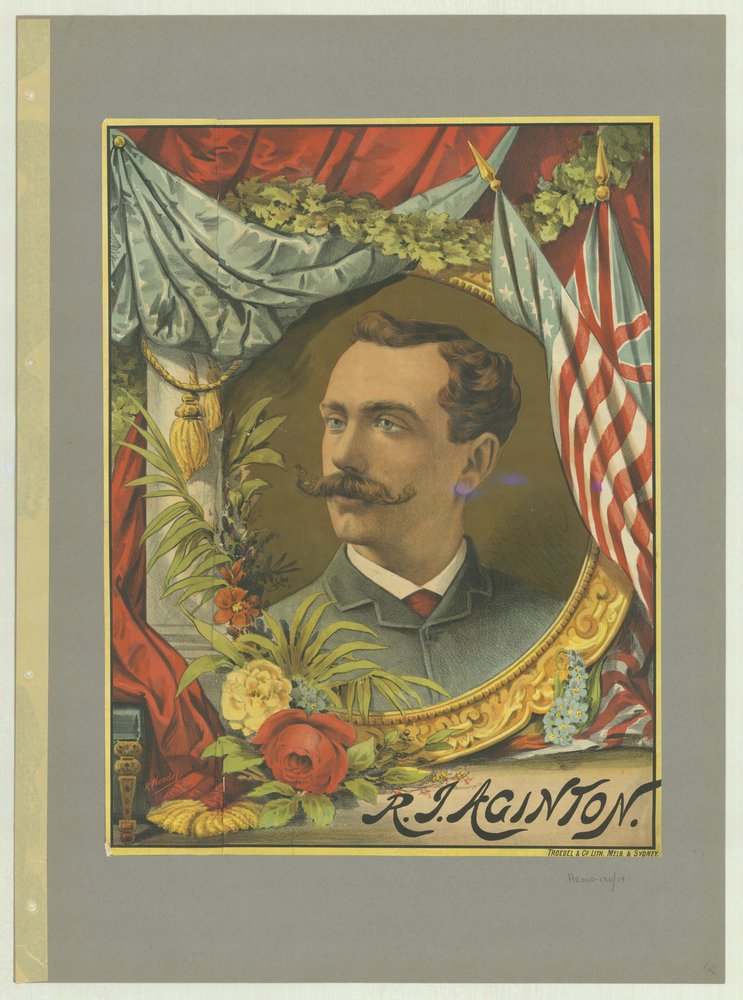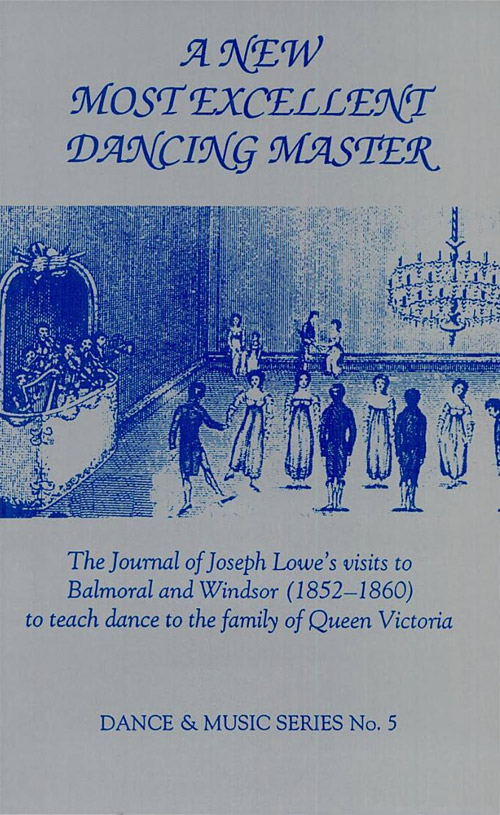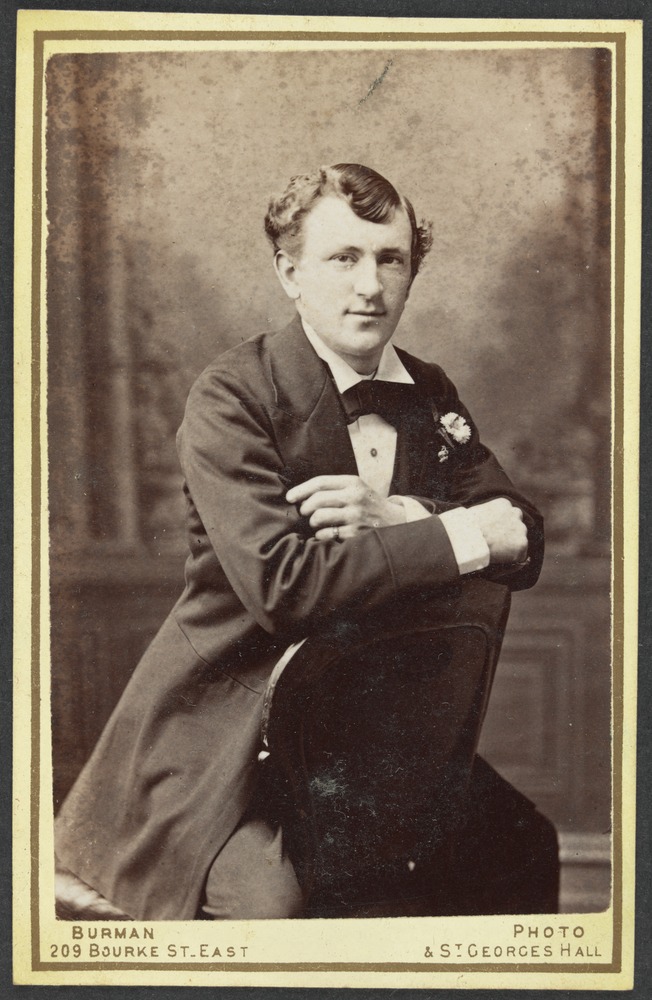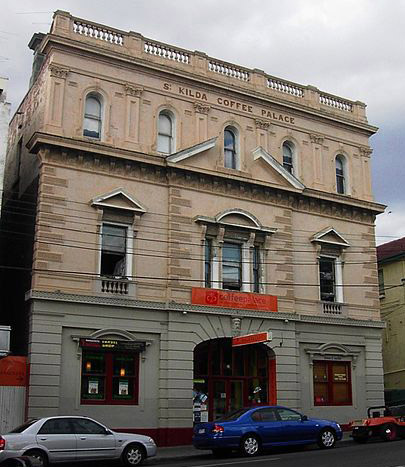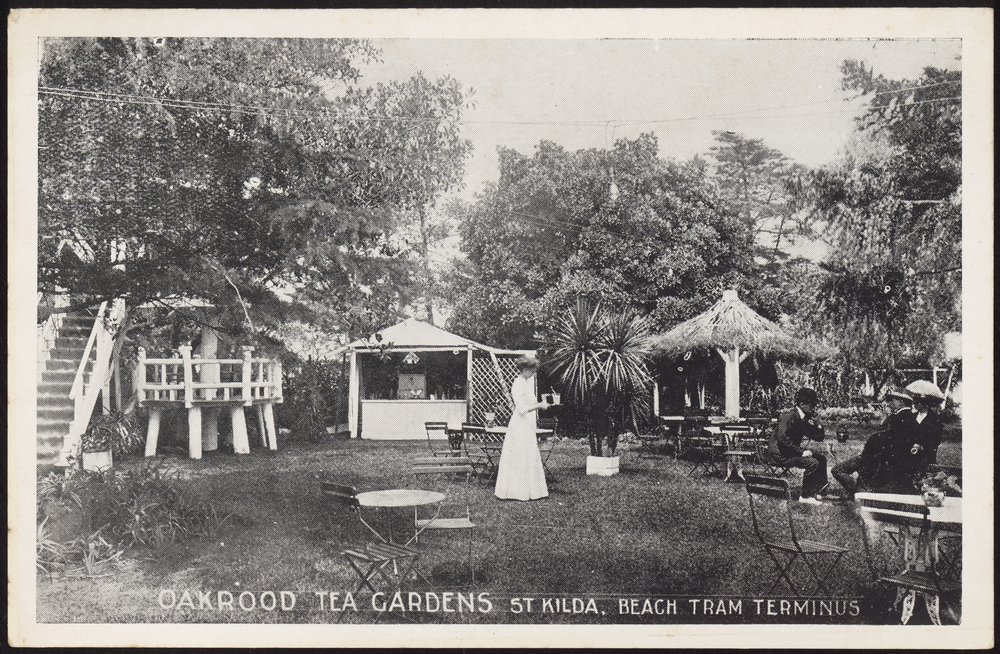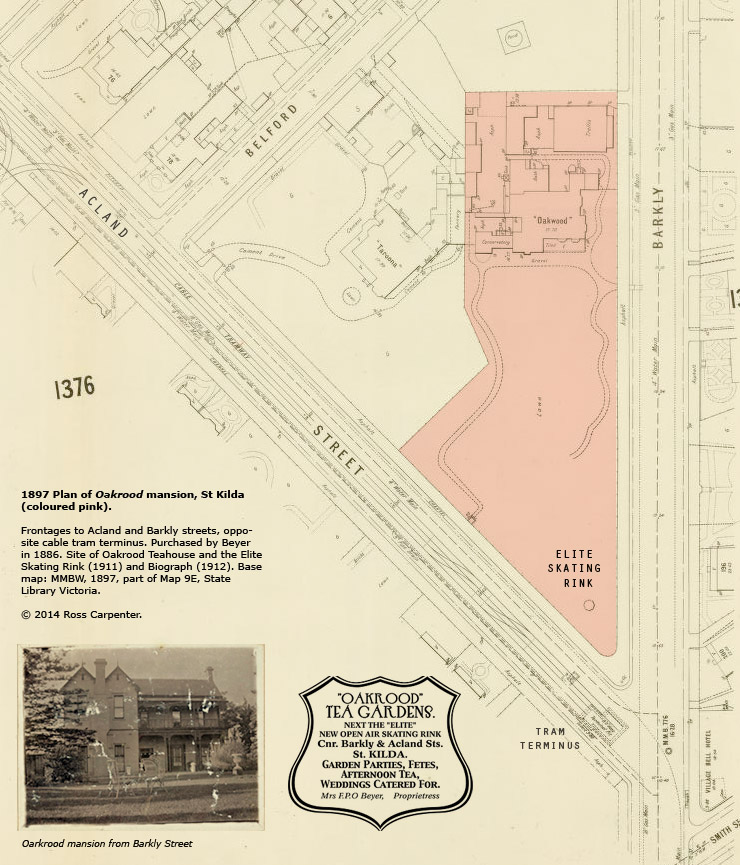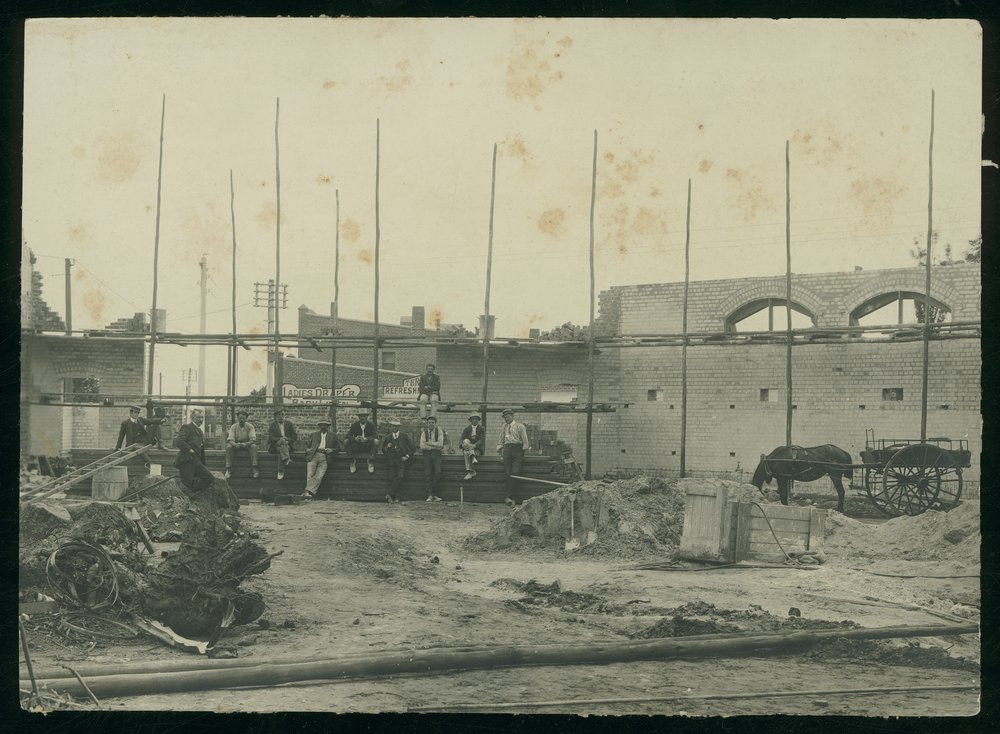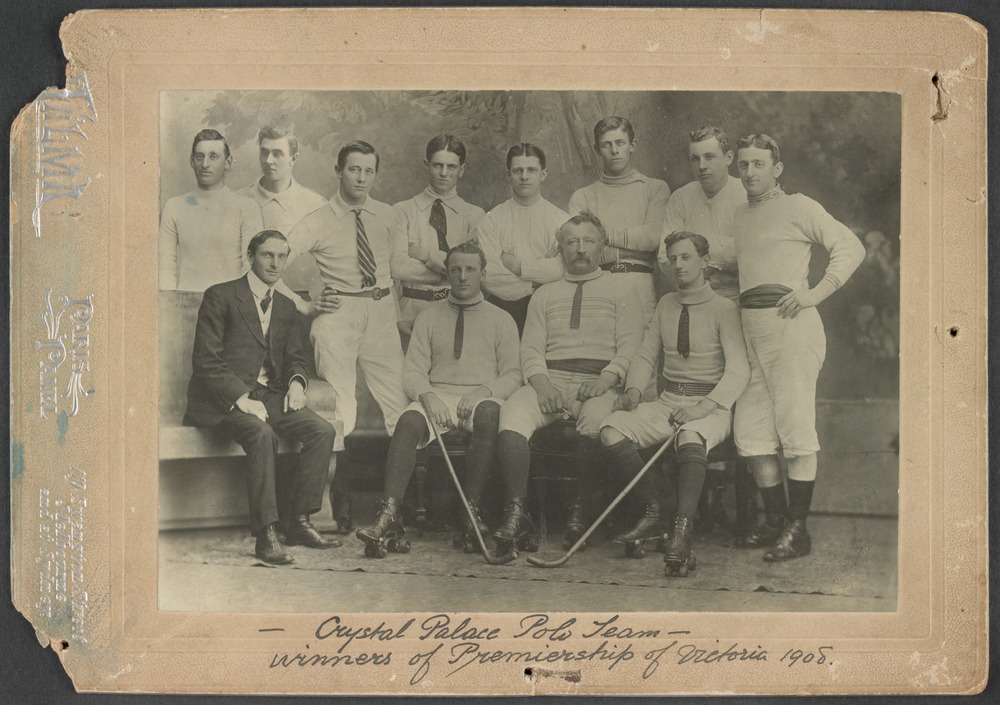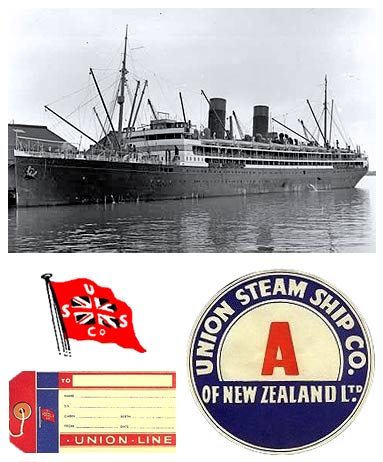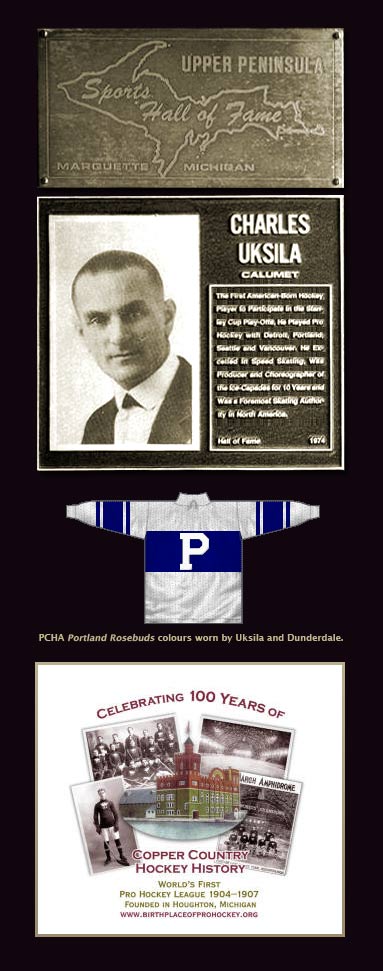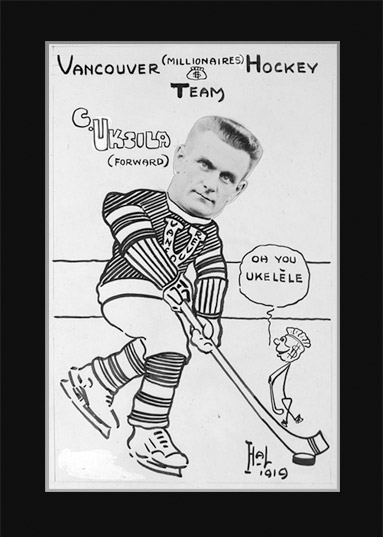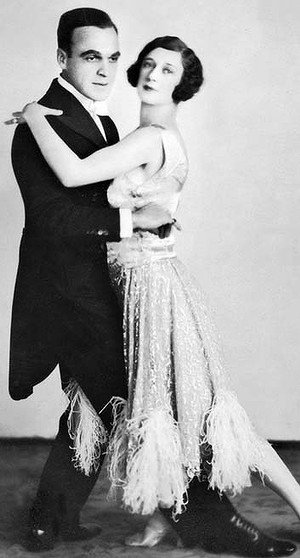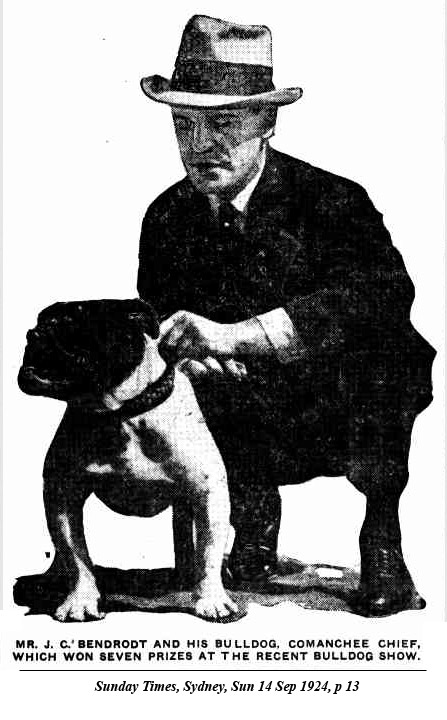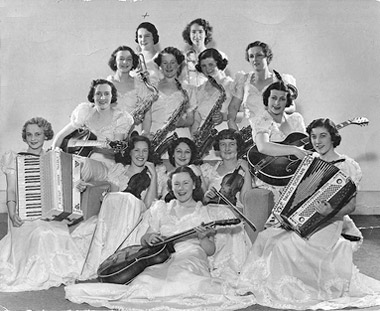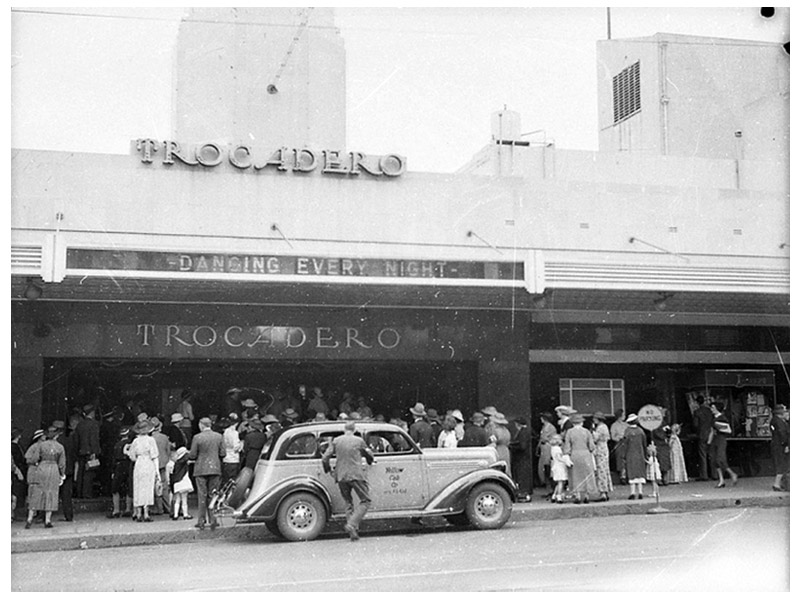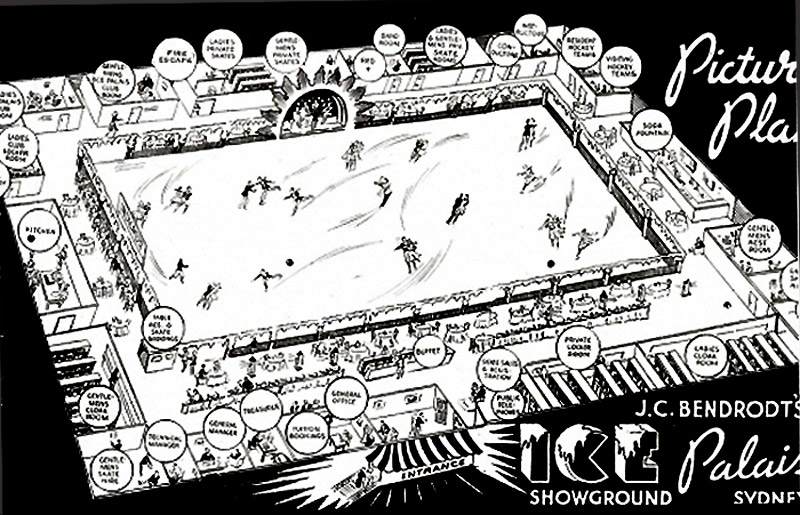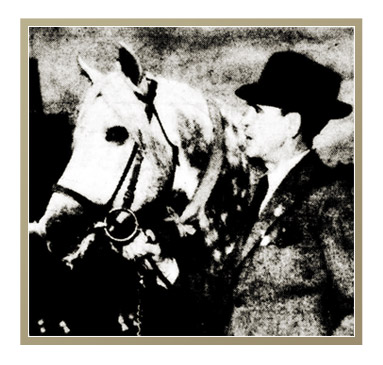Legends
home
1936 1st AUSTRALIAN Winter Olympian
1947 1st International Figure Skating GOLD Medallist
1960 1st Australian Olympic and World Championship ICE HOCKEY Teams Squaw Valley California USA
1961-2 2nd AUSTRALIAN Ice Hockey World Championship Ice Hockey Team Colorado USA
1963-4 2nd OLYMPIC Qualification ICE HOCKEY Team Tokyo Japan
1987 1st International Ice Hockey MEDAL Perth Australia
2008 Ice hockey World Championship PROMOTION TO DIVISION I Newcastle Australia
![]() . . . we are to have a novelty here in the shape of an ice rink — a real ice-rink. Melbourne hardly knows what ice is, except en bloc for edible purpose, and skating on it will be a new experience for our young colonials. A certain Rev Mr Macartney has lately uttered a most scathing diatribe on skating rinks in general, calling them sinks of iniquity, worse than music-halls, dancing saloons, and so on. But notwithstanding the reverend gentleman's outbreak, the sinks seem to be as much frequented as ever and I dare say this new one will have its full share of patronage. The prospectus poetically describes the ice-floor as one 'that will enable young Australia to realize the invigorating fields of ice on which their fathers skated.'"
. . . we are to have a novelty here in the shape of an ice rink — a real ice-rink. Melbourne hardly knows what ice is, except en bloc for edible purpose, and skating on it will be a new experience for our young colonials. A certain Rev Mr Macartney has lately uttered a most scathing diatribe on skating rinks in general, calling them sinks of iniquity, worse than music-halls, dancing saloons, and so on. But notwithstanding the reverend gentleman's outbreak, the sinks seem to be as much frequented as ever and I dare say this new one will have its full share of patronage. The prospectus poetically describes the ice-floor as one 'that will enable young Australia to realize the invigorating fields of ice on which their fathers skated.'"
— A response, in the year of the Melbourne International Exhibition, to the 1888 PROSPECTUS for The ICE and ROLLER SKATING RINK And ICE SUPPLY COMPANY LIMITED to build Australia's first ice rink in East Melbourne on land now occupied by St Vincent's + Mercy Private Hospital. The patron Sir William Clarke, 1st Baronet, lived at Clivedon in East Melbourne where the Hilton Hotel now stands. His name was a household word and he was reputedly the richest man in Australia. Although this combined ice and roller rink proposal did not proceed, it shaped an idea that was eventually built by H Newman Reid. [401] East Melbourne Ice Rink Prospectus
The Next Wave
From 1859 on...
![]() HIP OWNERS AND STOCKBROKERS. Squatters and mining entrepreneurs. Steelworks and gas company. Churchmen and federal senators. University boards and English public schools. And you will say, no way; they are as far removed from ice sports as you can get. And I will say, it might seem that way today, but it wasn't yesterday. Before engineered refrigeration, the cost of natural ice for those who had none was like today's oil pricing. Big business. It was also very costly to ship perishables. Coal and the gas it produces powered the first steelworks, the first iceworks, and just about everything else. Churchmen were responsible for the first schools that provided the knowledge, that made the products and services, that ran the businesses, that filled the ships. Engineers to prospect the raw materials and add tradable value. Stockbrokers to raise capital to finance industry and return dividends to investors. Senators to broker the International trade. Athletes to compete in the sports.
HIP OWNERS AND STOCKBROKERS. Squatters and mining entrepreneurs. Steelworks and gas company. Churchmen and federal senators. University boards and English public schools. And you will say, no way; they are as far removed from ice sports as you can get. And I will say, it might seem that way today, but it wasn't yesterday. Before engineered refrigeration, the cost of natural ice for those who had none was like today's oil pricing. Big business. It was also very costly to ship perishables. Coal and the gas it produces powered the first steelworks, the first iceworks, and just about everything else. Churchmen were responsible for the first schools that provided the knowledge, that made the products and services, that ran the businesses, that filled the ships. Engineers to prospect the raw materials and add tradable value. Stockbrokers to raise capital to finance industry and return dividends to investors. Senators to broker the International trade. Athletes to compete in the sports.
Australia was isolated by the tyranny of distance, but never entirely. From the moment it was founded, wool then gold powered Melbourne, its first free-enterprise colony, to knowledge, industry and International trade. The city's pioneering role in commercially-manufactured ice was simply trade competitiveness and inventiveness born of necessity in a remote, dry land. It had commenced very early; well before the first indoor ice rink was invented in London in 1876. And so it is not at all surprising that some of the pioneering innovators of knowledge, mining, industry and commerce in the young colony, were also the pioneers of Melbourne ice. Nor is it surprising that Robert Reid, the uncle of Henry Newman Reid, was one of Australia's earliest International trade ambassadors. He was a Victorian senator and one of Australia's foremost commercial magnates, regularly shipping between Australia, his head office in London, and another in Glasgow. These men were at the leading edge of commercially-engineered ice worldwide, and it was this that gave new impetus to the organisation of ice sports worldwide. The founders and foundations of modern ice sports in Australia, Britain and North America look astonishingly alike and interlinked. Because they were.
Modern commercial refrigeration commenced with the pioneering work in Melbourne by James Harrison, a successful journalist trained in chemistry who had earlier worked for the Glasgow printer, Edward Khull. They each immigrated to Victoria where Khull and John Goodall's grandfather became two of Australia's first stockbrokers at Ballarat during the 1850s goldrushes. Harrison patented the world's first commercial ice machine locally in 1854, and then went to London in 1856, where he also patented both his process and his apparatus. Siebe Brothers of Holborn used his designs to make improved machinery which was shipped to Victoria in 1859, and Harrison founded Victoria Ice Works at Franklin Street in Melbourne that year, then Sydney Ice Co in 1860, along with refrigeration for a Bendigo brewery. Convinced Australia’s industry would improve with the ability to trade meat with Europe, he began work on the refrigeration of ships for the export of meat, while competitors were still thinking only of direct freezing. In 1873, he sent twenty tons of beef and mutton to London in the ship Norfolk using his refrigeration methods. Despite the vested interests of importers of natural ice from North America, and an early failure due to lack of funds for adequate machinery that left him bankrupt, Harrison’s designs went on to revolutionise trade between Australia and the rest of the world, producing on a commercial scale the science that led to the world's first mechanically frozen ice rink.
Henry Reid's father and inventor John Gamgee were the same age, and both became educators in Edinburgh. Gamgee discovered his process for mechanically frozen ice rinks while attempting to develop a method to freeze meat for import from Australia, where Harrison was engaged on the same task. He worked on this in North America after 1868, and patented his process in London in 1870, sixteen years after Harrison's first patents. He then designed the original London Glaciarium, the world's first mechanically frozen ice rink. It opened in a tent just off the Kings Road in Chelsea on January 7th, 1876. In March, a rink measuring just 40 by 24-feet was established at a permanent venue at 379 Kings Road, and he produced two more small rinks in England. All three had closed by 1878, but Australia's historic breakthrough in commercial refrigeration came the next year, when the first successful refrigerated meat shipment left Melbourne and Sydney on the ship Strathleven, and was sold in London. At about the same time, the larger Southport Glaciarium (164 by 64-ft) opened using Gamgee's method near Liverpool where Lord Stanley was a local MP and, although it survived only a decade until 1889, it heralded the shape of things to come.
Australia's first ice rink syndicate was formed in 1888, during the same decade as the world's very first engineered ice rinks in England, and in the year of the International Exhibition in Melbourne. A group of local businessmen formed a syndicate and hired Arthur Otto Sachse (1860–1920) to develop an ice skating rink with an associated cold store and a roller skating rink on the first floor, at an estimated cost of £50,000. It was proposed to be located on land known today as the St Vincent's & Mercy Private Hospital — about half an acre with frontages to Grey and Gipps streets in East Melbourne, in an area which became the focal point of upper-class social life for the next twenty years. This prompted a local to write: "Melbourne hardly knows what ice is, except en bloc for edible purpose, and skating on it will be a new experience for our young colonials. A certain Rev Mr Macartney has lately uttered a most scathing diatribe on skating rinks in general, calling them sinks of iniquity, worse than music-halls, dancing saloons, and so on. But notwithstanding the reverend gentleman's outbreak, the sinks seem to be as much frequented as ever and I dare say this new one will have its full share of patronage. The prospectus poetically describes the ice-floor as one 'that will enable young Australia to realize the invigorating fields of ice on which their fathers skated.'" [401] The ice rink was to be 270 by 60-ft but it was never built, even though Sachse had patented his proposed process that year and the syndicate brokers, Keirl & Haynes, had publicly reported the shares had largely been taken-up and the share list would close on the 27th August.
Five years later, Reid's uncle Robert, a minister in the Patterson government, promoted the new trade in refrigerated shipping in Britain and North America, including lectures in Ontario, Toronto and Vancouver in 1893–4, when the first Stanley Cup was presented. The Stanley family returned to England that year, where Lord Stanley became Mayor of Liverpool and his sons helped establish ice hockey. Back home, late in 1893, the "frozen heart" of the ice pioneer, James Harrison, finally came to rest, and the grand era of ice rinks dawned. The first mechanically frozen indoor ice rink in North America was built in 1894 at Baltimore, Maryland, where organised hockey in America started late that year, and the National Skating Palace also opened the same year in today's London Palladium. They were followed in 1895 by Schenley Park Casino in Pittsburgh (225 by 70-ft); Niagara Hall Ice Rink in London (112-ft diameter); and St Nicholas Rink in New York (180 by 80-ft). In 1896 came the double-width Washington Convention Hall (205 by 155-ft), the new Dey's Arena in Ottawa (200 by 81-ft), and Prince's Skating Club in London (210 by 52-ft). Back in Australia, Reid commenced planning of the experimental Adelaide rink shortly after, and he was well-aware of these developments. In an interview with The Advertiser newspaper in Adelaide he gave the cost of Prince's as £42,000; and Schenley and Washington in the USA at £30,000 apiece. [357] Some of the Adelaide mechanical equipment was later relocated to Melbourne, where it was incorporated in the first competition-size rink in the southern hemisphere. Melbourne Glaciarium opened for the Winter of 1906, little more than a decade after the commencement of the new wave of engineered ice to the north. At 180 by 90-ft with seating for thousands, it was the third-largest, multi-functional ice arena in the world, as its builders well-knew.
Montréal's Victoria Skating Rink had opened much earlier in 1862, predating these first engineered rinks but it, and others like it, were not mechanically-frozen ice. Harrison's work had preceded them all by over a decade and, although development of the new technology took a further quarter-century, it provided a longer season there, and wherever else ice sports were dependent on naturally-frozen surfaces. It enabled ice sports to be organised anywhere, and by the late-1890s ice hockey and skating were becoming mainstream sports. Australia and America commenced ice hockey within a decade of each other, and they had forged a unique and lasting bond from the time of Australia's first ever organised game in 1906, against a visiting warship from New York. At the turn of last century, London, New York, Montréal and Ottawa were centres of excellence for ice sports in their respective countries, but also centres of all manner of related entertainments; from circuses, to theatre, to the "talkies". Melbourne ice sports had forged multiple links to all four cities by the end of their first decade and, as remote as it was, the city had nonetheless become a part of a well-traveled circuit, around which all manner of International trade now revolved.
But long before, from the driest continent, came the science of Melbourne ice.
Historical notes:
[1] Harrison's invention of a commercial ice-making machine in Geelong in 1851 led to locally manufactured ice being supplied in colonial Victoria for the first time. Until then, natural lake ice was imported predominantly from North America. It was a situation many wanted to keep in place. When the companies behind this lucrative trade realised Harrison’s ice-making machine was a threat, they saw fit to run him out of business. Others saw potential in this plan. In 1865, Australian pastoralist Augustus Morris offered a bonus of £100,000 for the first shipment of fresh meat from Australia to England by some form of refrigeration. Harrison was not the first to invent such a machine, but he was probably unaware of the others, and his designs were the first to produce ice in commercial quantities. [275] He returned to Australia in 1858, along with one or possibly two machines built by Siebe Brothers. He founded the Victoria Ice Works in Franklin Street, Melbourne and commenced to make and sell ice there in 1859. He also joined with the Sydney engineers P N Russell and Company in a venture to make and sell ice at a building behind the Royal Hotel in George Street. Having pioneered the trade to Britain of canned meat, and been relegated to a minor role by American competition, Australia was left in the 1870s with a growing surplus of meat that could not find a satisfactory market. Among those affected were the squatters and pastoralists, some of whom became closely associated with Victorian ice sports. It is, therefore, not surprising that Australia was in the forefront of efforts to pioneer a new meat trade with the aid of mechanical refrigeration. In the 1860s when commercial refrigeration was in its infancy, Harrison had been bankrupted, and only Thomas Mort in Sydney remained with the vision and the capital needed to apply this new technology to solving Australia's surplus meat problem. He considered himself fortunate to have discovered in Eugene Nicolle an engineering genius through whom he would bring his dream to fruition, and they purchased Harrison's patents. The Australians eventually found a way of reaching the British market, through the shipping skill and enterprise of the Scots, Bell, Coleman, McIlwraith and McEacharn.
[2] Andrew McIlwraith came from the port of Ayr, Scotland and after making frequent visits to Australia, satisfied with Company progress, returned to England 1885 to conduct the London end of the business Malcolm Donald MacEacharn settled in Melbourne Australia from Islay, Scotland and took many offices including parliament. They founded the firm of McIlwraith MacEacharn in London on February 1st 1875 when they began business as shipping and insurance agents. A year later they entered the ranks of ship owners following an agreement with the State of Queensland for the carriage of migrants from Britain to Queensland ports north of Maryborough. Their first vessels, eleven in all, were sail only, when they were also known as the 'Scottish Line'. In 1879, they chartered, the steamship Strathleven. Fitted with experimental refrigeration device aboard, she departed London and, on the return passage from Australia a shipment of 30 tons of frozen beef plus 2 tons of butter were carried. This cargo was found to be in excellent condition upon arrival on the 2nd October 1880. With the expansion of the company's interests in Australia, MacEacharn had settled in Melbourne about the time that a branch was opened and during his years there he took a leading part in public affairs, becoming a Commissioner of the Melbourne Harbour Trust in 1893, a member of the Melbourne City Council, and ultimately Melbourne's second Lord Mayor. He was also Vice Chairman of the Chamber of Commerce and Consul-General for Japan. In 1900 he was knighted and in 1901 elected to represent Melbourne in the first federal parliament. Four years later Sir Malcolm returned to Scotland and died in 1910 at the age of 58. His business partner Andrew McIlwraith died in 1932 in his 90th year.
[3] The single event that led directly to the establishment of an international trade in frozen meat was the voyage in 1879–80 of the sailing ship Strathleven equipped with Bell-Coleman refrigeration equipment, and carrying a shipment of forty tons of frozen beef, lamb and mutton from Sydney and Melbourne to London. The shipment quickly sold on the London market at a satisfactory price of around five pence per pound, close to the price of English fresh meat. Commercial shipments from Australia, New Zealand and North and South America followed and the trade soon became firmly established. Frederick William Armytage, grand uncle of Doris Armytage, played an important role in the development of the frozen meat export industry, and he owned a large part of this initial shipment. With Hastings Cuningham, Armytage had power of attorney to act for the Australian Frozen Meat Co, formed in Melbourne in April 1880, in arranging for freights and machinery. He was also an adviser to the Newport Meat Freezing Co, which established a slaughtering and freezing plant in 1882 at Newport, 7 km south-west of Melbourne's CBD. To bring this trade about, several conditions needed to exist: supplies of meat available for export; a market for the frozen product that could be profitably exploited; the availability of appropriate refrigeration technology; and entrepreneurs willing to invest money to establish a new line of business. Of all these conditions, it was the availability of reliable refrigeration technology that proved most elusive. Once that had been demonstrated, commercialisation quickly followed. The earliest efforts to find ways to establish an export trade in frozen meat occurred in Australia. Harrison's passion laid the foundation for today’s refrigeration and air-conditioning installations, including ice rinks; inventions that few could imagine living without. [275]
[4] Various histories [276] and US Hockey Hall of Fame records suggest Johns Hopkins University in Baltimore had possibly the earliest organized hockey games in the United States. Within the same story, Baltimore is also credited with building the first indoor arena in North America with artificial ice. History has it that the first competitive hockey match played in the United States was a contest between Hopkins and Yale University Bulldogs (New Haven, Connecticut) in Baltimore on February 1st (or 14th), 1896, although the first official games between these teams were played eighteen months earlier at Baltimore on December 26th, 1894, the year this rink opened. The Yale captain, Malcolm G Chace, and Arthur Foote had earlier gone to Canada and upstate New York for tennis tournaments, where they were exposed to the game the Canadians were perfecting, but which was yet to reach America. Chace and several friends decided to adopt the sport, replacing the more common US game of ice polo. They formed a hockey team at Yale and arranged for its first official games to be played at the newly-opened Baltimore rink on December 26th, 1894. The two schools tied 2–2, and eighteen months later, after facing off with the Baltimore Athletic Club on January 31st 1896, Yale again played Hopkins on February 1st, in the game now credited as the first American Intercollegiate game in history. It was apparently a stubborn and hard fought duel that ended in a 2-2 tie, and next day Yale won 3-2. Baltimore Athletic Club is now Charles Hall of the University of Baltimore and it was possibly the site of the first engineered rink in America, about which little else is known. Yale played home games on outdoor rinks in the New Haven area until 1911. [276] For Hopkins, Canadian Samuel Alfred Mitchell, an astronomy graduate student, was team captain and played second defense. G B Scholl, a second-year undergraduate, played goal in addition to serving as the team manager and treasurer. The team disbanded at the end of the 1897–8 academic year, citing transportation problems, disagreements between the rink management and the teams, and the lack of student support as the main causes. Yale continued the sport but there was a 90-year hiatus before competitive ice hockey returned to Hopkins. Yale now competes in the Ivy League and the ECACHL and has established the memorial position of Malcolm G Chace Head Hockey Coach, funded by a gift from the honoree's grandson, Malcolm G Chace, of Providence in Rhode Island. The two clubs now play a ceremonial game every year to commemorate the historic first game.
Robert Edward JACKSON and Louise LARSSON
Bobby (1892 - 1955) + Louise (1897 - 1958)
 APTAIN OF VICTORIA AT THE AGE OF SEVENTEEN, for the inaugural Goodall Cup ice hockey series in 1909 at Melbourne, then again in 1910 at Sydney. Bobby Jackson was the youngest son of George Edward Jackson of St Helens, The Vaucluse, behind St Ignatius Church in Richmond, an inner city suburb of Melbourne. [140] Travel records show he was 22 years-old late in 1914, suggesting he was born about 1892. However, he may have been the child born to Edward Jackson and Hannah Lewis at Melbourne in 1890, but that is not conclusive, and it is equally possible he was born elsewhere in Australia or overseas, although there are no other matching civil registrations in either Victoria or New South Wales. His eldest brother, George William Jackson (1882– ), may have been born at Willisham in Ipswich, England, later serving in the Royal Australian Navy on HMAS Australia. [140]
APTAIN OF VICTORIA AT THE AGE OF SEVENTEEN, for the inaugural Goodall Cup ice hockey series in 1909 at Melbourne, then again in 1910 at Sydney. Bobby Jackson was the youngest son of George Edward Jackson of St Helens, The Vaucluse, behind St Ignatius Church in Richmond, an inner city suburb of Melbourne. [140] Travel records show he was 22 years-old late in 1914, suggesting he was born about 1892. However, he may have been the child born to Edward Jackson and Hannah Lewis at Melbourne in 1890, but that is not conclusive, and it is equally possible he was born elsewhere in Australia or overseas, although there are no other matching civil registrations in either Victoria or New South Wales. His eldest brother, George William Jackson (1882– ), may have been born at Willisham in Ipswich, England, later serving in the Royal Australian Navy on HMAS Australia. [140]
Bobby Jackson had become one of the most accomplished amateur skaters in Australia by the time he first captained Victoria, less than five years after Reid's experimental rink in Adelaide first opened to the public. About three years younger than Andy Reid, and six years older than Albert Enders, he became the inaugural captain of Victoria, ahead of the first Australian ice hockey team players of 1906, which included Gordon Langridge and the captain, Canadian expatriate Herbert Blatchly, who had reached retirement age. He was also selected over Andy Reid, three years his senior, who was already an acknowledged champion athlete and ice skater. This historic, first ever Victorian Goodall Cup team defeated New South Wales with Andy Reid, Purbrick, Woods, Blair, Smith and Heywood at a time when Leslie Reid was still only 15 years-old. Jackson had become one of the most proficient ice hockey players in Australia, within three years of the opening of the first competition rink in Melbourne, and Blatchly had probably helped train him.
Jackson could have developed skating proficiency from a young age at the Crystal Palace Roller Skating Rink near his home at Bridge Road, Richmond, or he may have learnt on ice overseas. He had probably also formed an early association with former Canadian roller skater, Jimmy Bendrodt. They both performed for the same Melbourne theatrical company soon after Bendrodt had arrived in Australia early in 1911. Their association through skating, dancing and theatre was to span the first three decades of Australian ice sports. Bendrodt became a prominent Sydney dance instructor and promoter, and Jackson went on to become a professional ice skater, pantomime dancer, and musical comedy actor, performing on four continents, including America, South Africa and probably also Britain.
Jackson started his career as a stage dancer whose first known theatrical appearance was in 1911, in The Gay Gordons at the Criterion Theatre in Sydney, and perhaps also the Melbourne production at the Theatre Royal from 21 December 1910. [139] He was about 19 years-old, and this was the year that followed his first two Goodall Cup appearances; the year Jim Kendall first played Interstate hockey in Australia. In 1914, Jackson danced in the pantomime Puss in Boots, then traveled to Britain with "Mrs Jackson" the same year, returning for Christmas on the steamer Runic (2). This ship was a White Star Line steamer built for the Liverpool–Sydney via Cape run, which had earlier brought Jim Kendall to Australia. [140] The next year in Melbourne, Jackson married his ice-dancing partner, Sydney-born Louise Elsie Larsson (1897–1958), who had just turned 18. [140] Bobby Jackson was 23 years-old, and 17 year-old Louise had probably accompanied him to Britain the year before, raising her age by two years on the ship's register. His eldest brother, George, had married just three weeks earlier, and notice of both were published together in The Argus newspaper in Melbourne about two weeks later. [140]
Robert and Louise were married by the well-known Jesuit priest, Rev William Joseph Lockington (1871–1948), on April 12th, 1915, at St Ignatius' Church on Richmond Hill. This church still stands today next to Bobby's parents' former home on The Vaucluse. Lockington was one of the best-known Catholic priests in Australia, and 'the friend of half a lifetime' to the venerable Archbishop Mannix (1864–1963). He had been recalled to Australia in 1913, and worked as parish priest at Richmond until his appointment in 1916 as rector of St Patrick's College, East Melbourne. Between 1917 and 1923, he was superior of the eleven Australian Jesuit communities. In addition to overseeing four secondary colleges, one seminary and six parishes, he helped to establish Newman College at the University of Melbourne. During these years, Maurice MacGillicuddy, uncle of Cyril, was president of both St Patrick's Old Collegians and the Newman Society (see Cyril MacGillicuddy). Between 1923 and 1932, Lockington was headmaster of St Ignatius' College at Riverview on Sydney's Lower North Shore, where the Reid family lived after 1917. [140] Still to this day St Ignatius' is a sister school of Xavier College in Melbourne, which replaced St Patrick's Eastern Hill in 1900, as the sole catholic school in the then six-membered Associated Public Schools, with Scotch College, Melbourne Grammar and others.
Louise Larsson was the daughter of Swedish-born Lars and Jane Larsson of Dawes Point in Sydney, at the southern end of Sydney Harbour Bridge, adjacent to The Rocks. She first appeared in Australian theatre when she was 13 years-old, playing Lady Holyrood in the Aladdin benefit in Sydney in 1910. This was the lead character from the smash hit musical Floradora, first created by the English actress, Ada Reeve (see Cyril MacGillicuddy). J C Williamson's Aladdin pantomime had first opened at Her Majesty’s Theatre in Melbourne on December 18th, 1909, and traveled to Sydney for Easter 1910. Williamson had brought Lily Iris from England to play the principal boy. [139]
The skating exhibitions performed by the dancing Jacksons at Melbourne Glaciarium were very popular, particularly their tangos. In 1915, the young couple danced there with Claude Langley in an acrobatic skating demonstration, [151] and in October that year, soon after the outbreak of war, Jackson and Cyril MacGillicuddy registered the copyright of a musical work entitled "The Call". [91] Robert had been a professional skating instructor at Melbourne Glaciarium for "several seasons" by 1916 and, late that year, he and Louise left Melbourne for New York where he had been offered a position as a professional instructor at the Ice Palace rink in Riverside Drive, Manhattan, and a season at the Hippodrome Theatre (1905), aka New York Hippodrome. [137] The Hippodrome, located in the theatre district around Times Square and Broadway in mid-town Manhattan, was called the world's largest theatre by its builders, Frederick Thompson and Elmer Dundy, who were also creators of the Luna Park amusement park at Coney Island. It held 6,000 people, along with a 100 by 200-ft (30 x 61m) stage the size of an International ice rink, and a rising glass water tank. The stage was capable of holding as many as 1,000 performers at a time, or a full-sized circus with elephants and horses. In fact, Bobby and Louise worked there the year that Harry Houdini shot to even greater world prominence, by making a 10,000-pound elephant (with its trainer) disappear from the stage, beneath which was the water tank.
Six years earlier, Houdini had opened at the New Opera House in Melbourne on Monday evening, February 7th, 1910. He was part of a long programme of songs, dances and comedic sketches, which all began around eight at night and lasted for almost two hours. The next year, John Phillip Sousa and his band, creators of the music at the New York Hippodrome, played at Melbourne Glaciarium, the year the National Ice Skating Association of Australia (NISAA) was formed there. Known as the "March King", Sousa was an American composer and conductor who lived at Sands Point in New York. A band-member wrote: "At Melbourne we had the greatest reception given us by the citizens that the band ever received, completely putting the Sydney reception in the shade... the Glaciarium is a very cold building and the heating apparatus is not adequate enough to push sufficient heat into the hall, with the result that people won't come as they should". [140] Nonetheless, the band enjoyed good attendances in Melbourne. The year after in 1912, the famed Australian acrobatic equestrienne, May Wirth, made her debut for Ringling Bros in New York, and years later in 1924, the Australian tightwire artist, Con Colleano, launched his international career at the New York Hippodrome before a full-house of 6,000.
The Jacksons had joined the rush to New York, along with many other champion skaters from Europe, where ice sports were in disarray as a result of the war. The first 'ice show' in the world had been born at the Hippodrome the year before they arrived, and they probably danced in other Broadway theatres and the spate of New York 'tank shows' which had just become hugely popular. In fact, in 1917, the year the Jacksons arrived, one of these early tank shows was installed in the Waldorf-Astoria hotel where the family of Doc Murphy still lived. The Jacksons arrived in New York two years after Murphy had immigrated to Australia, when national ice hockey there was still suspended due to war. They taught famous people to ice skate and dance and performed with many others as described in this article, based on their interview for the Table Talk newspaper in Melbourne.
New York at this time was also the only city in the United States that supported an amateur ice hockey league. It had started around 1910, and it received a new lease of life around 1915–16, just before the Jacksons visited. Murphy had been captain of New York's Columbia University ice hockey team before he left to study in Germany in 1910, where the world's first ice ballet had been staged in Berlin in 1908. He attended Columbia between 1906–09 and played against other universities at New York's historic St Nicholas Rink, and no doubt others. Columbia University became a foundation school of the Ivy League, when it was formally established. The first formal league involving Ivy League teams was formed in 1902, when Columbia, Cornell, Harvard, Yale and Princeton formed the Eastern Intercollegiate Basketball League. As with Melbourne university, their founders also included some British graduates, although more from the University of Cambridge than Oxford, but also from the University of Edinburgh and elsewhere.
Lena Uksila, another world-class ice skater, [147] was also performing at the New York Hippodrome at this time. She would later join the professional instruction staff at Melbourne Glaciarium, and perform skating exhibitions with John Goodall, Jack Gordon and Enders and Cambridge. [146] Like the Jacksons, Lena and her brother Charles Uksila were an American ice dancing couple whose careers had started in Michigan. Lena had learnt to skate in the 1900s, at a time when American professional skaters were pioneering miniature ice revues in hotel supper clubs on small portable ice stages called "tanks." They were adapted from the popular vaudeville shows and Broadway musical revues of the time, in which dancers like the Jacksons appeared. The 5,200-seat Hippodrome produced the first ice shows in the world this way, including a lavish ice ballet imported from Germany in 1915; the sensational final act of its huge stage extravaganza "Hip Hip Hooray." This was the first Broadway ice show and the star was Charlotte Oelschlagel, aka Charlotte Hayward (1898–1984), a professional German skater. The following year, Irving Brokaw (1870–1939), the American ice dancer, olympian and former national amateur men's champion, brought “Flirting at St Moritz” to the Hippodrome. Performed by the Berlin Ice Ballet, it ran for 300 days before a 6,000 seat house; a record on Broadway at the time. The leading skater, 17 year-old Charlotte, shot to stardom overnight. Her name went up in lights, songs were written about her, and she made the first ice skating film (The Frozen Warning, 1916). The public fell in love not only with Charlotte, but also with skating. She was the first female skater to include an axel jump in her performances, and she and her partner, Kurt Neuman, invented the death spiral and the candlestick spiral (also known as a charlotte). Charlotte was inducted to the World Figure Skating Hall of Fame in 1985.
The Jacksons first worked with the ice dancing Uksilas at the New York Hippodrome in 1917 and, unless they had already met, it was there that they had probably also been introduced to Victorian-born ice hockey star, Tommy Dunderdale. Dunderdale was the first Australian to be inducted to the Hockey Hall of Fame, having commenced his playing career in Canada many years before Jackson became the first captain of Victoria in the inaugural Goodall Cup. Tommy first played hockey in Ottawa, Winninpeg, Montréal and Québec, and he may have already been known to Jackson through Herbert Blatchly, who had played hockey in Ottawa for over a decade before Dunderdale had first arrived there in 1894 as a young boy. The Melbourne-Ottawa-New York connections of these three earliest Australian ice hockey captains, appear to be more than mere coincidence. By the time Jackson arrived in New York, both Dunderdale and Uksila were playing together with Portland Rosebuds based at Portland Ice Arena in Oregon, USA. It was there two years earlier that Charles Uksila had become the first American-born ice hockey player to participate in the Stanley Cup playoffs, and Dunderdale the first Australian. Both moved to the same Canadian league in nearby cities after the 1917–18 season; Dunderdale rejoining Victoria Aristocrats and Uksila joining Vancouver Millionaires, based at the Patrick brothers' Denman Arena; Vancouver's first mechanically frozen rink, and one of Canada’s first.
Baltimore in Maryland, USA, was home to the first ever mechanically frozen ice rink in North America in 1894, and the historic venue of the first officially-recognised ice hockey game in America in 1896. Australia's fledgling ice hockey league was linked to America from its inception in 1906, when the first match took place between Melbourne players and a visiting American warship, USS Baltimore (see 1st Team). The ship had been out of commission at New York Navy Yard since 1900, but from 1903 she served with the North Atlantic fleet and in the Mediterranean, cruising in Asiatic, Philippine, and Australian waters, before returning to New York in April 1907. America and Australia had commenced organised ice hockey within a decade of each other, and the sport in Melbourne and New York had shared a unique bond since this historic 1906 game. A decade later, there was probably no better place on earth for ice sports than New York in 1917–18. Champions from all over the world had gathered there; Broadway ice shows were born there in these years; and the NHL was formed in 1917. Bobby and Louise were a part of history in the making.
The Jacksons had returned to Melbourne by July 1919, when they were billed "from America" and performed "grand exhibitions" at Melbourne Glaciarium. [137] In December 1919, they joined J C Wiiliamson's Royal Comic Opera Company (1881-1925) as specialty dancers, working together in Theodore and Co and then in Kissing Time the following year, both at the Theatre Royal in Melbourne. Jackson was also paired with Maie Baird and both feature on the cover of the sheet music for Almond Eyes from Theodore and Co. Both musicals starred Gladys Moncrieff (1892–1976), who was soon to become a frequent celebrity guest at Melbourne Glaciarium carnivals and charitable events, and who would later drop the first puck of a Goodall Cup test (see John Goodall). [137, 139] Theodore and Co, Oh Lady Lady, and Maid of the Mountains were among the best of a long line of musical comedies that came to characterise the 1920s in Australia, featuring such local stars as Moncrieff.
At the end of the First World War a tide of relief flooded the world; the bloodshed was over and it was time to celebrate life. The Roaring Twenties had arrived, and noise became a necessity, accompanied by the cacophony of technology. There were motor cars, motor bikes, aeroplanes, and towards the end of the era, the talkies. An increasing sense of freedom for women was reflected by short skirts and demands for economic independence, and these new-found freedoms extended to a quest for identity. The term "Australian" was increasingly used to denote singers, dancers, actors and celebrities. These sweeping social changes were reflected in the theatre, and local stars became household names. Sensationalist dramas and musicals jostled with variety and silent films for patronage, and women’s stage roles became more complex and disturbing. During this period, the legitimate stage, primarily dominated by J C Williamson in Australia, now concentrated on the production of light musicals and sensational dramas.
In 1920, the Jacksons were among the cast of J C Williamson's A Pageant of Empire and The Boy, both of which were staged at Her Majesty's in Melbourne. The Louise Larsson dancing troupe was formed soon after her return from New York. It peformed on the Star Suburban Circuit and included the young dancer, (Sir) Robert Helpmann (1909–1986) and his sister, Sheila. [138] The troupe provided the early vehicle that helped launch Helpmann to International fame. Within five years, his father had arranged his introduction to the touring dance company of the Russian ballerina, Anna Pavlova, in Melbourne. Frank Bladen, one of the musicians in Pavlova's orchestra, became the conductor of the Melbourne Glaciarium orchestra. Later that year, Jackson played John Rodriguez in the stage production of Cecil B De Mille's romance, Fool's Paradise, the silent movie that opened at the Palace Theatre in Bourke Street in Melbourne. The stage version was intended to embellish the movie, and cost over £5,000 in costumes and sets. It had ten principals, a ballet of thirty, and a chorus of twenty-five. [137] He next appeared in Hugh J Ward's Tangerine in 1923, which ran for 36 weeks, and also The O'Brien Girl, both at The New Princess Theatre, Melbourne. The O'Brien Girl produced a souvenir programme for its 150th performance, and Jackson also performed in Ward's Little Nellie Kelly at the Prince of Wales Theatre in Adelaide.
The American-born actor and theatrical entrepreneur, Hugh Joseph Ward (1871–1941), first arrived in Sydney in 1899 with Charles H Hoyt's comedy company. He returned to the States and also worked in London before settling in Australia in 1908. There he became managing director of J C Williamson Theatres, but resigned in 1922 to set up Hugh J Ward Theatres Pty Ltd with the Fuller brothers. The O'Brien Girl was their first production. Ward later lived in a huge mansion at Pott's Point in Sydney and his wife, Grace Miller Ward, became well known on the concert platform, and also as the singing teacher who 'discovered' Gladys Moncrieff. John Goodall married Kathleen Fanning during these years, the Melbourne soprano who appeared in many stage productions, and who was an understudy to Moncrieff in the vehicle that launched her to fame. By then, Bobby Jackson was an older contemporary of Professor Jack Gordon, and he was still instructing at the Melbourne academy and performing fancy skating exhibitions with Gordon and Professor Spencer. One was attended by Gladys Moncrieff and other "theatricals...at the invitation of the management" in 1923. Most were from the cast of Tangerine, in which Jackson was then appearing at the Princess Theatre:
"... Among the theatricals who were present at the Glaciarium skating rink yesterday afternoon at the invitation of the management were Misses Gladys Moncrieff, Mamie Watson, Ena Dale, Lorna Pounds, Toots Pounds, May Beatty, Cecil Bradley, Clarice Hardwicke, Mr and Mrs Claude Fleming, Messrs. Mark Daly, Robert Jackson, and Lance Lister. Features of the programme were the exhibitions of fancy skating by Messrs, Robert Jackson, Spencer, and Gordon, and an ice hockey match." [137]
Two weeks later, Lena and Charles Uksila arrived in Melbourne under a 14-week contract with Melbourne Glaciarium, which had no doubt been arranged through the Jacksons. The Uksilas had visited Australia in the Winter of 1920 a few years after Jackson visited. Charles was an "athletic trainer" and, on this occasion, Lena was attached to the professional instructional staff and both she and Charles were contracted to perform ice dancing and skating exhibitions. Lena was met at Spencer Street station by members of the National Ice Skating Association of Australia on July 27th, 1923, and she was billed at the Glaciarium as the 'woman champion ice skater of the world,' from the Hippodrome theatre in New York. [158] This was the federation year of Australian ice hockey and Charles was also contracted to coach an Australian ice hockey team, which was most probably the Victorian State team, following their victory over New South Wales the season prior (see Charles Uksila). [146, 147] If so, Jim Kendall and Charles Uksila were the two coaches who clashed for the Goodall Cup in the federation year of ice hockey in Australia, and it was Kendall who took the honours. New South Wales defeated Victoria, the reigning champions, in a closely fought contest (see John Goodall).
Before the advent of Australian ice, many in Jackson's generation of ice skaters first learnt to roller-skate at Wirths' Park Roller Skating Palais de Luxe in Melbourne, and its forerunners and interstate equivalents. Roller rinks had preceded ice rinks in central Melbourne and St Kilda by forty years or more. One had probably opened at South Gate before Melbourne's first ice rink, and one was certainly part of Wirth's Park, along with the Hippodrome Circus and the Olympia theatre-cinema. It was established on the site of the present Arts Centre by Phillip Wirth (1864–1937) in 1907, and one of its advertisements in The Argus on August 25th, 1923 read, "751st week — Still Booming" It styled and promoted itself as the "best rink in Australia" with the "best skating floor in Australia". The huge Glaciarium complex, rink, ice cream plant and ice works, stood directly opposite, and so ice skating and roller skating, today's inline, sat side-by-side for a very long time near Prince's Bridge, right there in the heart of Melbourne.
Among the many other roller rinks in Melbourne's inner suburbs at the time were the Elite Skating Rink , on the corner of Barkly and Acland Streets in St Kilda; the Crystal Palace Skating Rink (bef 1905–16) in Bridge Road, Richmond near the Jackson and MacGillicuddy residences; St James Park Skating Rink at Hawthorn which was destroyed by fire in 1890; [286] the Colosseum in Prahran, which was possibly located in the Colloseum building in Chapel Street near the town hall, before it was taken-over by the well-known drapers around the turn of the century; the Jubilee Skating Rink in Carlton; and Victoria Skating Rink in Yarra Street, South Yarra, the same street in which the family of Norm Joseph had lived. There were many others, particularly in the bayside towns and resorts stretching all the way to the Mornington Peninsula.
Horace Turner owned the Victoria Skating Rink in South Yarra, and it was he who took-over Adelaide Glaciarium in late-1907, converting it to the Elite Roller Skating Rink, named the same as Peter Beyer's St Kilda rink. Beyer also managed the Richmond rink in Melbourne as well as the Jubilee Exhibition (Roller) Skating Rink in Adelaide in the early 1900s, immediately prior to the opening of Adelaide Glaciarium. He had purchased the mansion Oakrood in the mid-1880s, which had been built on the Barkly-Acland corner in the 1860s, with gardens laid out by the designer of Melbourne’s Botanic Gardens, Baron von Mueller. [285, 287] He built the rink in the gardens, and used the rest for the rare and exotic Oakrood Tea Gardens, operated by his wife, Janet. It was no coincidence that these and other roller rinks were located in the inner urban suburbs which later produced many of the first ice champions of Victoria and Australia, and also the first ice hockey clubs.
A plaque on the Comedy Theatre in Melbourne describes George Selth Coppin (1819–1906) as "Philanthropist and Father of the Theatre in Victoria". He had set-up a roller skating rink in Hines Assembly Room in Adelaide as early as 1868, the first in that city. This was about the time that Coppin had closed his Cremorne Gardens amusement park at Richmond in Melbourne's inner city. By mid-1888, an enterprising American, A N Ridgely, had opened the Columbia Elite Roller Skating Rink in the Exhibition Building on North Terrace where Beyer later set-up, with a seating accommodation for upwards of 3,000 patrons and a rink measuring 195 by 95 ft. Rinking revivals continued in most States until around 1911; their demise hastened by the coming of the silent movies, and the grand era of indoor ice rinks. Yet, Wirth's rink opposite the Glaciarium in Melbourne had continued on for decades. Coppin went on to establish Melbourne's theatre land, and the earliest ice-related patent on record in Australia dates back to his 1866 invention for a roller and ice skate, perhaps three years after Plimpton's Skates were invented in New York. It was this American, James Plimpton, who perfected the roller skate; developed a system of rinks; and obtained the patronage of the best of society for the sport that came to be known as 'Rinking'.
As it happened, Plimpton's New York manager, Robert James Aginton (1859– ), had toured Australia in the late 1880s. His first appearance was at the Exhibition Building, Melbourne on December 27th, 1886. Nicknamed The Monarch of all Roller Skaters, he was an acknowledged world champion, and a professional skating instructor based in San Francisco, on the Pacific Coast of America, where a branch of the Goodall family lived. He was also well-known to A N Ridgely of the Olympian Club Rink in San Francisco, who had established the Columbia Elite roller rink in Adelaide, South Australia, in mid-1888 (see The Morning Call advertisement at right and the Columbia poster at links below). Aginton returned and settled in Australia, having found that roller sports there "attracted so much attention." He was employed as a professional instructor by a Melbourne rink for an enormous fee of £100 a week, and he later opened his own rinks in Sydney and Toowoomba, 132 km west of Brisbane in Queensland. H J Wallace and A J Smith, two aspirants to Aginton's world title, were both Melbourne roller skaters. [159] Wallace's challenge for the world title took place at St Kilda in June 1887.
Skating had been common in the theatre world for quite some time, and it partly explains why Melbourne had many fine skaters within a few years of the opening of Melbourne Glaciarium. The situation in Adelaide, Sydney and Brisbane was also similar, and this is one of the reasons why caution needs to be exercised in attributing too much unfounded glory to ice skaters such as Dunbar Poole. Poole was proficient on ice, but some highly-skilled roller-skaters and dancers made the transition to ice very quickly when the first ice rinks opened in Adelaide, Melbourne and Sydney, and there were others who had learnt to skate overseas, before they had immigrated to Australia. The National Skating Association of Great Britain had assumed responsibility for roller skating in 1893, and did not relinquish it until 1990 when a separate roller authority was set up. In fact, the first wave of elite ice skaters in Australia were trained by a world-class professional skating instructor from Prince's Skating Rink in London, but also an Australian roller skating champion (see Figures). The second boom in Australian roller sports had been fostered by world champion skaters from the Pacific Coast of America, such as Aginton, Ridgely and Davidson, and it had continued on into Australian ice sports like a tradition, through Pacific Coast ice champions such as Charles and Lena Uksila.
Melbourne Glaciarium became the first picture theatre in Australia in 1906 and films were first shown in New South Wales at Sydney Glaciarium. Thomas James West was the exhibitor and he also converted Adelaide Glaciarium to a cinema after the ice and roller rinks closed. In November 1912, his company merged with two other pioneering film exhibitors in Australia to form the General Film Co of Australia. By January next, General Films merged with Greater J D Williams Amusement Co to form the exhibition company Union Theatres, and the distribution company Australian Films Ltd. At that time, the group controlled 29 theatres, but by 1921 they had expanded to more than 80, and by the end of the twenties, they had the largest cinema chain in the country, larger even than Hoyts. [273] The Williams amusement company with which West had merged was formed by the American, James Dixon Williams, and the Phillips brothers from Seattle — Herman, Leon and Harold.
At the time, Williams personally directed Melbourne's Luna Park on the St Kilda foreshore. Now the world's oldest amusement park under private management, it first opened on December 13th, 1912, and its direct antecedent was Luna Park on Coney Island in Brooklyn, New York, built nine years earlier in 1903 by Frederick Thompson and Elmer Dundy, builders of the New York Hippodrome. In the silent film, "Marvellous Melbourne — Queen City Of The South" (1910), St Kilda featured as "The Coney Island of Australia", and they did indeed share important historical parallels. Both began in the mid-1850s and developed as fashionable seaside resorts for the nearby cities. Both New York and Melbourne underwent booms in the latter part of the century, which led to expansion, improved transport systems, and the consequent encroachment of the metropolis on the resort, resulting in a shift from exclusive bayside suburb to entertainment venue for the masses. [274]
The opening attraction of the 1913 season at Luna Park St Kilda was an open air performance by the world champion roller skater, Harley Davison, who later performed with Charles Uksila at the opening of the Palais de Glace in Los Angeles in 1925, the first ice rink in California. Williams returned to America in 1913 and founded First National Films which later became Warner Bros. His company owned a number of theatres in Seattle and Los Angeles, and Melbourne's Luna Park in St Kilda was just one of the many entrepreneurial and theatrical schemes he initiated with the Phillips brothers in both Melbourne and Sydney. Another was Melbourne's Palais de Danse which they built next to Luna Park in 1913. Jimmy Bendrodt, the Canadian roller skater and dance promoter, had arrived in Melbourne from Britain three years earlier in 1910. During these years, Bendrodt was manager of the new Imperial Roller Rink at Hyde Park in Sydney, which he then reopened early in 1914 as the Imperial Salon De Luxe, catering for American dance crazes. The roller rink at South Yarra in Melbourne was renamed Salon de Luxe soon after, then The Plaza, before it was finally converted to a cinema late in 1915; about the time Bendrodt commenced work with J C Williamson's Theatres in Melbourne.
That same year, the Palais de Danse building was converted to Palais Pictures, but the dance hall was recreated on an adjoining site, when a new cinema was built on the Palais Pictures site in 1920. [274] This ran for a couple of years unti its interior was entirely redesigned by Chicago architect Walter Burley Griffin and his wife, just before they commenced the Café Australia and Capitol building projects for Antony Lucas, who had two daughters active in Melbourne ice sports. In 1916, Beyer's Elite Skating Rink became the third picture-theatre in St Kilda bearing the name "Palais". According to Beyer’s grandson, "grandfather became interested in pictures" when the skating craze faded. [285] However, the roller rink also continued to operate there until 1938. It was home to the 1928 Victorian roller skating championships and stocked 1,500 pairs of Brampton skates.
In 1913, White City opened in Rushcutters Bay, Sydney, with attractions similar to Luna Park in Melbourne. An earlier theme park, the Royal Aquarium and Pleasure Grounds at Sydney’s Tamarama Beach, had featured two roller skating rinks between 1887 and 1906 when it closed. But it wasn't until 1935 that Herman Phillips designed and established Sydney's Luna Park at Milson's Point on the North Shore, using artists from Melbourne's Luna Park. The Floating Palais, a covered pontoon moored alongside Crystal Palace at Sydney's Luna Park, was initially used for roller-skating until it became the Palais de Dance in 1939. By 1935, Bendrodt had extended the promotion of his Sydney Palais Royal dances and bands to Melbourne's Palais de Danse. He too was associated with the Phillips brothers from that time on, and perhaps much earlier. Within a few years he had converted his Palais Royal to the Ice Palais rink in Sydney. The year after, St Moritz ice rink opened at St Kilda, on the Upper Esplanade above the Palais de Danse and the new Palais Pictures, today's Palais Theatre, which was completed by the Phillips brothers in 1926 (see Harry Kleiner). St Moritz took over a building originally built as a dance hall, but then occupied by Efftee Productions, one of the largest film studios in Australia at the time. It was purchased in 1933 by Francis William Thring (1883–1936), a noted film producer, and partner in the nationwide Australian theatre circuit, Hoyts. Efftee studios only functioned for four months at St Kilda, and the business and building passed down to the founder's son, Old Grammarian and actor, Frank Thring (1926–1994). Thring retained the freehold of the structure until 1955, and so Kleiner must have leased the building from him. [285]
These developments in the Australian and American entertainment industries were essentially pioneered by many of the same entrepreneurs. Cinema grew to dominance in the industry from its birth as a poor relation of vaudeville and live theatre interests (J & N Tait, J C Williamson’s, the Fullers and the Carrolls). Independent operators and filmmakers in both countries were simultaneously replaced by larger combines through amalgamation and absorption, in tandem with similar live theatre amalgamations involving J C Williamson and J & N Tait. Australia mirrored trends in the United States, driven by the same entrepreneurs and their need for more capital to meet public demand for better picture theatres, and films of greater technical and logistic complexity. Peter Fogarty, writing for the St Kilda Historical Society, observed: "... what is most striking in St Kilda though, is the combining and re-combining during this period of these people: Johnson, Gibson, Griffith, West, Lincoln, Cass, J & N Tait, Houldin, Stuart, B & J Fuller, F P C Beyer, J Steventon, V C Marshall, F Thring Snr, J D Williams and the Phillips Brothers. As The Star commented in 1921: 'In a business sense there is much moving in movieland. Amalgamations and re-arrangements being many, while a number of our prominent picture-men have gone to America and elsewhere on business visits.' This comment would have had equal validity throughout the preceding sixteen years". [285] The Australian-America connection began life in the Melbourne entertainment world at the very moment Melbourne Glaciarium and its Adelaide predecessor were established, including West's films. But they were preceded for almost forty years by their skating forerunners — the quad roller rinks — which were as successful in Australia as anywhere else in the world. In fact, according to experts like Aginton, they were more popular in Australia than anywhere else, and they endured there, long after each successive worldwide craze had died.
Jackson was one of the four men's figure skaters Victoria sent to the inaugural "Australasian Championships" held in Sydney in late-August, 1931, with Cyril MacGillicuddy, Frank Mercovich and Jack Gordon. He was still among the best skaters in Australia in his late-thirties. The four Victorian women's competitors were Winsome Thackeray, Phyllis Turner, Vera Pincott, and Dorothy Tickle. [166] Jackson was Victorian and Australian National Pairs Figure Skating champion in 1931 and 1932 with A Maxwell. In the same years, he was Victorian and Australian National Dance (Waltz) Champion with Phyllis Turner. [173] This couple had won the 1931 championship held in Sydney, over second-placed Cyril MacGillicuddy and Winsome Thackeray, the Australian National Women's Champion in 1933 and 1934 (there were no women's titles in 1931–2). Jack Gordon, Ken Kennedy and their partners tied for third-place. [134] These 1931 titles were the first ever "Australasian championships", [134] and Jackson had earlier won other 'Independent' National titles. Australian ice sports also owe a small but very important piece of their heritage to Jackson. He kept many of the theatrical and ice sports programmes with which he had been associated, including Ice Skating in Australia (Aug 1931 and May 1932); La Fiesta Ice Carnival at the Sydney Glaciarium; Melbourne Glaciarium newsletter Glaciettes (July 1937). The Melbourne Punch newspaper photograph of the historic first team of 1906 is the oldest image of an Australian ice hockey team known to exist. However, Bobby Jackson has preserved the oldest known original photograph of Australian ice sports — the 1910 Victorian ice hockey team — the second team ever to be formed in Victoria. Jackson was captain with Andy Reid, Keith Curwen-Walker, [18] John Goodall, Cyril MacGillicuddy, William Woods and Blair.
Robert Jackson and Sydney's Jack Pike were the first ever State captains to face-off for the Goodall Cup. Like Pike, Jackson's involvement with Australian ice sports spanned three decades, from their very beginnings until the late-1930s, and perhaps beyond. Unlike Pike, Jackson was also a highly accomplished figure skater and theatrical dancer, with International experience from Britain, South Africa and New York. He preceded Jack Gordon and coached early Melbourne skaters in a role similar to Dunbar Poole in Sydney. The links he forged with the Melbourne, Sydney and International theatre world raised the profile of Australian ice sports, and led to the appointment in Melbourne of some of the earliest International coaches for both ice hockey and figure skating. Jackson's dancing and theatrical links had also helped to develop early relations with North Americans such as Canadian expatriate promoter, Jimmy Bendrodt; players such as Jim Kendall; and administrators such as Doc Murphy. In conjunction with Herbert Blatchly and Bendrodt, he was a key proponent of innovations occurring in the Pacific Coast Hockey Association in Western Canada between 1911–18, and its Michigan antecedent (see Ted Molony). Bendrodt's penchant for promotion, and his Australian roller and ice rinks, were relatively important catalysts in the development of the Australian sport. Jackson's part in introducing world-class coaches such as Charles and Lena Uksila, and his own professional contribution to the development of Australia's first generation of figure skaters, particularly in ice dancing, helped to quickly establish the preeminence of Melbourne's Academy of Skating on that side of the world. Bobby Jackson was Australia's first professional ice show star and skating instructor at the International level, and he captained Victoria to victory in the first two Goodall Cup clashes ever played. He died at the age of 63 in London in 1955, and his wife Louise died in Melbourne three years later at the age of 61. She was interred at Springvale Botanical Cemetery in Clayton, Victoria on September 10th, 1958 (Boronia Wall Niche L 92). [140]
Bobbie - Australian Contributions:
The Gay Gordons, Criterion Theatre, Sydney, NSW, 1911
Puss In Boots, Her Majesty's Theatre, Melbourne, VIC, 1913-14 (and possibly South Africa)
Theodore and Co, Theatre Royal, Melbourne, VIC, March 1919
Katinka, Her Majesty's Theatre, Melbourne, VIC, 8 June 1918
Maytime, Theatre Royal, Adelaide, SA, 1 Nov 1919
Katinka, Theatre Royal, Adelaide, SA, 8 Nov 1919
Kissing Time, Her Majesty's Theatre, Sydney, NSW, 26 Jan 1920 (not in 1924 revival)
Kissing Time, Theatre Royal, Melbourne, VIC, 24 May 1920 (not in 1924 revival)
Kissing Time, Theatre Royal, Adelaide, SA, 6 Sep 1920 (not in 1924 revival)
A Pageant of Empire, Her Majesty's Theatre, Melbourne, VIC, June 1920
The Boy, Her Majesty's Theatre, Melbourne, VIC, Oct 1920
So-and-So's Company, Garden Theatre, Adelaide, SA, Feb 1921
The Boy, Her Majesty's Theatre, Sydney, NSW, 28 Jan 1922
J C Williamson's So-and-So's, Garden Theatre, Adelaide, SA, Jan 1921.
The Ugly Duckling, Theatre Royal, Adelaide, SA, Oct 5 and 6, 1922
Fool's Paradise, Palace Theatre, Melbourne, VIC, Nov 1922 (stage presentation of movie)
Tangerine, The New Princess Theatre, Melbourne, VIC, 9 June 1923
The O'Brien Girl, The New Princess Theatre, Melbourne, VIC, 1923
Little Nellie Kelly, Prince of Wales Theatre, Adelaide, SA, 1923
La Fiesta Ice Carnival, Sydney Glaciarium, 1936
American Contributions:
1917-18 Season at the New York Hippodrome
Pom-Pom, with Mitzi Hajos, American Tour, 1918 [562]
Louise - Australian Contributions:
Theodore and Co, Theatre Royal, Melbourne, VIC, March 1919
Maytime, Theatre Royal, Adelaide, SA, Oct 1919
The Boy, Her Majesty's Theatre, Melbourne, VIC, Oct 1920
Kissing Time, Her Majesty's Theatre, Sydney, NSW, 26 Jan 1920 (not in 1924 revival)
Kissing Time, Theatre Royal, Melbourne, VIC, 24 May 1920 (not in 1924 revival)
Kissing Time, Theatre Royal, Adelaide, SA, 6 Sep 1920 (not in 1924 revival)
J C Williamson's So-and-So's, Garden Theatre, Adelaide, SA, Jan 1921.
The Ugly Duckling, Theatre Royal, Adelaide, SA, Oct 5 and 6, 1922
Look Your Best, West's Wintergarden, Adelaide, SA, (with her Sunbeam Kiddies), Dec 1923
Healo, Theatre Royal, Adelaide, SA, 1924 (Choreographer)
Louise Larrson Troupe, Star Suburban Circuit, 1924
American Contributions:
Pom-Pom, with Mitzi Hajos, American Tour, 1918 [562]
Louise Larrson's Troupe | 1920 | Theatricals | 1923 | St Kilda Foreshore | Map | 1913 on | 1933 | Hugh J Ward | 1940 |
Historical notes:
[1] In 1915, Robert's eldest brother, George William Jackson (1882– ) married Ruth Margaret Kendell at St Joseph's Roman Catholic Church in Malvern. She was the youngest daughter of Edgar Kendell of Carlton. George may have enlisted in the Royal Australian Navy in 1919, an Able Seaman on HMAS Australia until his discharge in 1940. His wife lived at Hartpury, Milton Street in St Kilda in 1945, the year their son, George Edgar Patrick, wed Margaret Louise Robertson, the daughter of H D Robertson of 30 Tennyson Street in Elwood. Able Seaman George William Jackson gave his birthplace as "Illisham" of which there is no known record. It may have been "Willisham" in Ipswich, Suffolk, England, however, the origin of this family remains uncertain.
[2] Riverside Drive is in Manhattan and its indoor rink was the Ice Palace, located on the corner of 181st Street, near George Washington Bridge, on the west side. This was a different rink to the old Ice Palace at 107th Street and Lexington Avenue, where ice hockey was first played in New York in the early 1890s. New York had three rinks in 1916 and a fourth, Brooklyn Ice Palace, opened on January 17th, 1917 at Atlantic and Bedford Avenues, Brooklyn; about the time that the Jacksons had arrived. It was 85 by 200-feet, with seating for 1,000, and it claimed to be the fifth largest in the world. It was home to the Crescent Athletic Club of Brooklyn which competed in the New York Amateur Hockey League 1896–1918, aka United States Hockey League. The earlier rinks were the original St Nicholas Rink (80 by 180-feet), corner of 66th Street and Columbus Avenue, which was important in hockey history and which, like the Melbourne rink, had been modeled on the 1876 London Glaciarium; the Ice Palace at 181st Street; and Iceland Rink on Broadway and 53rd (52nd in some sources). The war in Europe had left ice sports there in disarray, and Irving Brokaw's ice events at the St Nicholas Rink and the Hippodrome in 1915 had given New York ice sports considerable impetus, transforming the city into a popular destination for the European skating champions and professionals. [New York Times, Dec 24, 1916, p E9 and Jan 14, 1917, p S3] The first figure skating championships were held at the St Nicholas Rink in 1897, and the last, a "North American Championship," was held in 1918, which was about the time the Jacksons returned to Australia.
[3] Cooper and Bailey's Great American International Circus — the lineal ancestor of today's famous Ringling Bros and Barnum & Bailey's Combined Shows — first pitched its big top tent on the Wirth's site in 1877, thirty years before Melbourne Glaciarium was built opposite. Its carnival-style parade through the streets of Melbourne aroused a sensation in 1877. In Sydney, its two ring exhibitions attracted as many as 5,000 spectators to each performance. In 1882, the Wirth family launched the circus which became Australia's largest and most prestigious. In 1898, Wirth's Circus toured England, the first Australian circus to do so. Fitzgerald Brothers' Circus, Australia's biggest circus of the 19th century, permanently pitched its home there in 1901. Three years later, other attractions had amassed on the site where the Arts Centre in Melbourne stands today, including a Japanese Tea House, open-air theatre, miniature train, water chute and even a 15-member military band. In 1907, Wirth Brothers' Circus took over from Fitzgerald and built their own Hippodrome with a roller skating rink, while Olympia was leased as a cinema. In the 1920s, dancing halls grew up, including the Green Mill Dance Hall (later the Trocadero), but by the second world war the area was becoming dilapidated, and eventually Wirth's site was destroyed by fire in 1953, four years before the Glaciarium also burnt for the last time. Although many English performers found their way to the colonies, only two circuses of English origin visited Australia. These were Harmston’s (in 1890–1 and again in 1897–8) and Bostock & Wombell's in 1906. They were a continuous source of fresh talent and ideas for the local circus scene. The size and splendour of the American circuses quite eclipsed their Australian contemporaries. Their menageries, the boastful advertising, grand parades, circus trains and other trademarks were adopted by the largest Australian circuses which gradually divested themselves of a staid British heritage. Some Australian circuses ventured from the 1880's onwards to destinations in the Pacific, Asia and beyond. In the 1890's and the early 1900's the large Fitzgerald and Wirth's circuses regularly engaged acts from America, England and the Continent.
[4] For a good overview of the history see the Chronology of Theatrical & Professional Figure Skating compiled by Susan Austin MA, for the Professional Figure Skaters Cooperative.
THOMAS JAMES WEST ( 1855 – 1916 ) The Scotsman, Thomas James West, aka T J West, was formerly a press agent for Barnum & Bailey who operated as an optical lanternist in Edinburgh from around 1897, under the business name of Modern Marvel Co Ltd, which also exhibited scientific novelties such as X-rays and moving pictures. Each year he screened a programme of new short films at the Queen’s Theatre in Edinburgh (today's Edinburgh Festival Theatre). [485] In the late 1890s West teamed up with The Brescians, a costume concert company, touring England and Scotland as West's Pictures and The Brescians. Henry John Hayward (1865–1945) was the The Brescians company manager, and in 1905 they decided to take the show to New Zealand where Hayward's sister had emigrated. [485] Hayward was also an active member of West's Pictures, as was his brother Rudall Hayward. He later developed the chain of theatres known as Hayward's Picture Enterprises which merged with the interests of the Fuller brothers to become Fuller Hayward Theatres Ltd. [486]
Half the programme was concert and half short films. The segment of 14 films ran for 80-minutes in New Zealand and included documentaries such as Firemen at Work in London, travel films, Tour Through Italy, and In Barcelona Park (in “stereoscopic kinematography”), an instructional film, Busy Bee – Every Phase of Bee Culture, and a comedy, Burglar and the Girls. It concluded with an outstanding film of the period, Trip to the Sun, an early space thriller and trick film produced by the Frenchman, Herbert Melies. It had been hand coloured by a line of women, each painting one tint. [486] This show was a huge success, touring New Zealand for most of 1905. The Australian touring rights were won by Sydney-based theatrical entrepreneur Edwin Geach.
West returned to Edinburgh for his annual screenings at the Queen’s Theatre, then back to Sydney in March 1906 to rejoin The Brescians for their Australian tour. This was the year Melbourne Glaciarium opened and West had arrived with a swag of new films including a short version of the hugely influential Living London (Charles Urban, UK, 1904). [478] It was the beginning of the fierce rivalry between West and promotors J & N Tait, whose concerts also incorporated short films. After three years' profitable touring in New Zealand and Australia the company disbanded and West concentrated on his film company, [486] eventually moving his centre of business here and creating Australia's first cinema chain. [478] He continued to exhibit films in the off-seasons at Australia's first ice rinks in Melbourne and Sydney (see Henry Newman Reid). A 1909 advertisement claims West's Pictures employed over 300 people worldwide, including Australia and New Zealand.
In Britain, West was the director of West's Pictures, film exhibitors of 12–13 Piccadilly Mansions, Piccadilly Circus at Westminster in London. He was often wrongly confused with Alfred John West (1857-1937). [408] He was also a Director of the Cinematograph Defence League (CDL) and the General Film Agency. CDL, located at 18 Charing Cross Road in Westminster, was a trade body formed to deal with the Cinematograph Act from January 13th, 1910. The co-directors were William MacLean Borradaile (shipping agent), R T Jupp (showman), H E Poole, and Montagu A Pyke, Britain's first cinema king and owner of the Pyke Circuit of London theatres. Pyke opened Britain’s first public cinema on Edgware Road in London in 1905, the year before Melbourne Glaciarium, Australia's first cinema. The General Film Agency (Dec 1912–Aug 1916) was a cinema equipment manufacturer or supplier located at 58 Dean Street in Westminster. It was formed in part out of the purchase of Williams Bioscope Co Ltd of Elm Lodge, Wraysbury, Bucks. They were agents for E Duckel in Paris (Leopold Sutto) who are agents for Milano, Skandinavia and Russisk. This company had moved to 24 Denmark St in January, 1916.
Sydney Glaciarium was used by West's Pictures in the off-season, opening Saturday December 7th 1907 with a house of thousands, up until early-1916. The rink was covered for theatre and dance use. West's Pictures was the first to exhibit in Sydney. The company also operated in the summer months at Melbourne Glaciarium which was located at Princes Court (1904), an entertainment precinct similar to Luna Park adjacent to Olympia, a permanent circus site, built in 1901 by the Fitzgerald Brothers' Circus. Prince's Court was a fashionable meeting place with a Japanese Tea House, open air theatre and a giant water chute in addition to the rink. The Wirth Brothers took over the site in 1907 and West leased the Olympia building, opening Melbourne's first cinema there in 1909. It was opposite the Glaciarium at the corner of Sturt Street and City Road, South Melbourne. However, Frank Talbot was first to screen moving pictures in Australia at Melbourne Glaciarium, [484] even before the Tait Brothers, directors of J C Williamsons and West's main rivals, presented moving pictures there. West's Pictures merged with Amalgamated Pictures in November 1912 and it in turn became part of Australasian Films Ltd in 1913.
Yet West's company still operated West's Glaciarium and Olympia Theatre in Oxford Street, Sydney, throughout the war years. At Sydney Glaciarium in 1914, Fortune's Wheel and The Primitive Instinct. The Barnstormers, a semi-theatrical production in four parts, was exhibited in 1915. [479] Also The Way Back and The Shulamite in November. De Groen's Vice Regal Orchestra supplied the incidental music. [480] In January 1916, the sixth series of The Clutching Hand entitled The Hour of Three andThe Blood Crystals. The Australia Gazette was also shown. [481] The Destroying Anger was exhibited in February [482] and others, but it seems West's Pictures finished at Sydney Glaciarium early-1916, the year West himself died in London. Boy-Girl screened at Sydney Glaciarium in 1917; a Blue Bird film, not West's. [483]
JAMES LEONARD PLIMPTON (1828 – 1911) He was an American inventor born in Medfield, Massachusetts who is known for changing the skating world with his roller skates. He patented a design in 1863 which included a pair of wheels in the front, and another pair in the rear of the chassis; a truck that had a pivot motion; a rubber cushion on each truck, so that the skater could lean in the direction of the turn (lobe); and toe and heel clamps which he replaced with straps and buckles in 1866. He was the father of the quad roller skates, and of the business and sport of roller, or inline, skating as we know it today. He owned a furniture business in New York City, where he had a skating floor installed and began the business of leasing his roller skates. He converted the Atlantic House Ballroom in Newport, Rhode Island, into a skating rink and opened it to the general public in 1866; the first ever "general skating session". He founded the first roller rinks in New York, and the New York Roller Skating Association (NYRSA) in order to promote roller skating as an American pastime. Upset by patent infringements, he developed a ‘proficiency test program,’ so that skaters who chose to use his skates could be rewarded with a medal of proficiency. By 1870, his tests and medals were being given in twenty countries, including Australia.
Although George Coppin in Melbourne imported two hundred pairs of skates from Plimpton in 1866, his ice and roller skate design patented from Hobart the same year was certainly "inspired" by Plimpton's 1863 skate. In fact, the image in the patent application looks like a Plimpton skate and the skate's specification is the same. Moreover, Coppin's application in March 1866 was only the first of the spate of skate patents in Victoria that year. Leopold Burmeister followed on June 11th. Thomas Rea applied on June 20th for a skate "...with single line of rollers each revolving on two centres or sockets". On July 19th John Frederick Droop patented a method of "guiding skates by the inclination and pressure of the foot". On August 4th, William Bourne Say applied unsuccessfully to patent a skate with "(1) a mode of obtaining a rocking motion; (2) facilitation of turning; (3) metal axle box; and (4) wheels made in a single piece." On September 1st, Robert Anderson applied to patent "...an arrangement of a ball-and-socket joint, by means of which curvilinear motion is secured." It too was refused and Victoria's patent office saw no more until Horace Kimball applied on May 9th 1871. [510] These years were the dawn of Plimpton's worldwide ‘roller skating craze’, and yet Plimpton's former manager, Robert J Aginton, and the Winslow Skate Co, were to contribute even more to Australian skating .
![]() Plimpton and Aginton | 1888 | Adelaide Roller Ball Poster signed by A N Ridgely | 1888 |
Plimpton and Aginton | 1888 | Adelaide Roller Ball Poster signed by A N Ridgely | 1888 |
Brisbane Demise | 1890 | Toowoomba Prizes | 1909 |
GEORGE SELTH COPPIN (1819 – 1906) The comic actor and entrepreneur George Coppin was first to introduce roller skating to Melbourne from his Apollo Music Hall in Bourke Street. That was in 1866, the same year the world's first ever "general skating session" was conducted by James Plimpton in America. Coppin imported "rinking" on his return from a successful tour of the USA with British actors Charles Kean and his wife Ellen (Tree). [503] Coppin was the Kean's agent at the time and they were in America between 1864 and early-1866 at the dawn of the "rinking" craze. Coppin engaged Professor Fuller from New York, "the champion skater of the world," for exhibitions and instruction back home in Melbourne. Boston-born William H Fuller was the American Champion in 1865 and 1866, succeeding Jackson Haines (1840-1876), the father of modern figure skating. [506] Fuller"introduced roller skating to the Australian public" after a performance of Twelfth Night at the Apollo on the 7th April 1866. [507] The author of Roller Skating Made Easy wrote in 1884:
In writing of modern skating, it is interesting now to recall the record of Mr William H Fuller, a young American, who left New York in 1865, and gave exhibitions of roller skating while crossing the continent to California. From San Francisco he sailed to Australia, practicing on shipboard during the voyage. After remaining many months in Australia he went to India, Turkey, Egypt, and then to Russia, in the frozen North, where one might naturally expect to find skating in its greatest perfection ; and even there he "astonished the natives" by his skill in "figure skating," such as seemed marvelous to the Russians. [505]
Coppin also brought back sufficient knowledge to patent and market "Coppin's Patent Roller Skates", and whatever else he thought necessary to repeat Plimpton's success. [504] The publican, George Henry Tipper, leased the Apollo hall from Coppin to operate Tipper's Skating Rink, the first in Australia. It opened in May 1866, a month after Fuller's first performance. [507] Tipper was the proprietor of the Haymarket Hotel which was situated in the same building, adjoining the rink to the rear. In June the same year, a notice appeared in The Argus newspaper informing the public the prospectus of "The National Skating Association" would shortly be issued "for the establishment of rinks and the manufacture of skates under Mr Coppin's patent". It also mentioned that the Melbourne Skating Club and the Victoria Skating Club met on Monday and Wednesday nights, respectively. [511] They operated successfully for 5 years as part of a model Coppin imported from America in the form of Plimpton's 1863 patented "rocker skate" and the organisational structure Plimpton had used to establish America's first roller skating association and rinks. The image of the roller skate in Coppin's patent application is almost identical to the Plimpton skate (images below). This account from the Association Prospectus was published in July 1866:
There appears to be a probability that Sale, and other interior towns, may ore long have its own Skating Rink, a novelty which has been introduced to this colony by Mr Coppin with great success. It is proposed to form a National Skating Association (Limited), to purchase from Mr George Coppin his patent for the colony of Victoria, entitled " An Invention for a Patent Roller and Ice Skate," by which he enjoys the solo right to the manufacture and disposal for a period of fourteen years of ''Coppin's Patent Roller Skates " to carry on the skating rink so successfully established at the Apollo Hall, Melbourne; to promote and license skating rinks throughout the colony; "and to manufacture, let, and otherwise dispose of "Coppin's Patent Roller Skates." From the great and increasing success of the skating clubs in Melbourne, and the numerous applications already received from towns in all parts of the country, it is estimated that upwards of 50 skating rinks will be immediately established when a sufficient number of skates can be manufactured to supply the demand. As each rink will require at least 100 pairs of skates of various sizes, and a constant supply to maintain the stock, a profit of £5,000 from this source alone can be obtained by the disposal of skates upon moderate terms; in addition to which, the requirements for private families and schools will doubtless be very extensive. A considerable income will also be derived by imposing a small license fee upon each public rink - say, 4d per week - giving a clear profit upon 50 rinks of £520 per annum. The receipts during the six weeks that the Melbourne Rink has been open, omitting capital account, were £440 10s; expenses, £136 14s 5d; giving a net profit for the six weeks of £303 15s 3d. The profits of the company will enable the share holders to give themselves many extra privileges in connection with the rink, in addition to their own skates. It is proposed to give Mr. Coppin £5,000 in money and shares upon his assigning to the company his patent for Victoria, 150 pairs of skates, and all his interest in the rink at the Apollo Hall. Coppin will be a large shareholder, and will actively assist in the management of the company's business. The services of Mr. W. H. Fuller, the champion skater of the world, can be retained on the term of his engagement with Mr Coppin. [509]
In 1876, a history of skate patents worldwide appeared in an important London journal. It noted: "... in the Melbourne Herald of April 7th, 1866, that one Fuller, the champion skater, had been engaged to give a performance being the inauguration of roller skating in the colony. In the Herald for the 9th there is an account of the performance, and a statement that 200 pairs of skates had been shipped from America but were overdue. In May a public skating rink was opened in the city, the skates used having been furnished to the above-mentioned Mr George Coppin, by Mr Plimpton." [510] Later in 1866, the struggling Prince of Wales Theatre in Sydney underwent a "grand transformation" to convert its stage into a skating rink for the Australian debut of Professor Taylor, the champion skater of Canada. It operated as Sydney's first rink for a short time. [513] The Australian Roller Skating rink followed on 8 September 1866 in a hall on the site that became the London Chartered Bank at 90 Bourke Street in Melbourne, but it too was short-lived. [514] .
In May 1868, Coppin set-up a roller skating rink in Hines Assembly Room in Adelaide, the first in that city. By May 1871, Tipper was insolvent losing most of his estate to pay his debts. [517] He was also the publican of the Café de Paris (1859) in the Theatre Royal at the time, a favourite literary and artistic meeting place also managed by Coppin. The rink in the Apollo music hall was destroyed by fire in September 1871, and the same fate awaited his café in the Theatre Royal a few months later. Coppin was able to rebuild both within six months. Tipper was well-known for kindness toward theatricals and the regular get-togethers he arranged for the city's publicans at his rink. He left for London a year or so later without his wife, Mary Ann, who died shortly after he left, just 34 years-old. [515] George Tipper, the operator of Australia's first skating rink, became manager of London's Criterion Theatre soon after it opened at Piccadilly Circus in 1874. By the 1880s he was publican of the Golden Fleece, at 8 Queen St, Bank, just off Cheapside, and a few minutes walk from St Paul's. From 1883, he also operated "the whole of the handsome and commodious saloons, smoking lounges, and refreshment rooms" at the Philharmonic Hall, 40 Islington High Street, London. [516]
Joseph Lowe opened Melbourne's next rink in Exhibition Street about the time Tipper departed Port Melbourne. The introduction of roller skating to Australia was a financial success, but nothing like the success Plimpton had earlier generated in the United States. The scope and expected returns of Coppin's National Skating Association prospectus of 1866 were not realised for another 20 years. Coppin was a member of the Central Board of Health when it approved Ridgely's roller skating rink opposite the St Kilda Railway Station two decades later on 26 November 1886. [512] The Elite Columbia Skating Rink in St Kilda was the first rink in a speculative skating boom that was systematically multiplied by Americans in each Australian state over the course of just three years. The speculation also spawned Australia's first investment propectus for an ice rink at East Melbourne in 1888, a few years before the dawn of the grand era of indoor ice rinks worldwide (1890–1920). The American roller skaters who exhibited here were world class exponents of "scientific" skating. Their expertise was derived from the figures on ice developed by Jackson Haines (1840-1876) and his contemporaries in New York in the early 1860s, shortly before Haines left for Vienna.
![]() Coppin's Patent Application | 1866 | Skate Designs | 1860-6 |
Coppin's Patent Application | 1866 | Skate Designs | 1860-6 |
ROBERT JAMES AGINTON (1859 – ) "The Monarch" of America first appeared in Australia at the Royal Exhibition Building in Melbourne on December 27, 1886. Aginton's skating career had begun almost a decade earlier as manager for James Plimpton in Philadelphia from 1877. He helped Plimpton establish the popularity of roller skating in Baltimore; Washington; Atlantic City, New Jersey; Lowell, Massachusetts; New Haven, Hartford; Worcester; Connecticut; and three seasons in Boston. The supply of Plimpton skates ran out during those years, and The Samuel Winslow Skate Company of Worcester, Massachusetts opened. Finally the world had a practical roller skate. Their “Vineyard” model line became the most popular skate produced during the 1880s, selling at an affordable price. Frank Winslow was proprietor of the Boston and Vineyard rinks and no doubt related to Colonel Samuel Ellsworth Winslow who had founded the skate company with a brother.
Aginton left Plimpton to work with Frank Winslow as a professional skater, giving exhibitions throughout North America in the numerous rinks which had since sprung up. He and Winslow parted in 1886, and Aginton went on a successful exhibition tour of the world with W S Maltby, the famous trick bicycle rider. The tour coincided with the arrival in Australia of the American roller rink entrepreneurs, Ridgely and Washburn. Aginton said he decided to return to Australia after the tour because skating was more popular in Australia than anywhere else. His title to the championship of the world remained undisputed for many years during the 1880s. In June 1887, he competed at St. Kilda against H J Wallace of Philadelphia for £200 and the championship of the world. The contest was in "scientific" skating (figures) and Aginton unanimously won even though Wallace was highly skilled and graceful, a former ice skater who claimed he became "scientific" roller champion of America. There is no evidence Wallace was a champion, but he was one of numerous expert skaters brought to Australia by Ridgely, who later returned to give skating exhibitions in most states.
Aginton's Australian exhibitions were very successful and he was hired for £100 a week at the Palais de Luxe roller skating rink at Wirths' Park opposite Melbourne Glaciarium. In May 1889, he opened and managed the newly erected Darlinghurst Skating Rink in Sydney, opposite Darlinghurst Gaol (today's National Art School). The rink was 350ft x 130ft and he imported Winslow "Vineyard" roller skates to hire and sell there. Aginton last skated in Sydney in May 1891. He had become manager of the zoo in Indianapolis, USA, by 1901 and then manager of Bostock's Circus in Philadelphia by 1906.
![]() Plimpton and Aginton | 1888 | Brisbane Demise | 1890 | W S Maltby | 1890 | Toowoomba Prizes | 1909 |
Plimpton and Aginton | 1888 | Brisbane Demise | 1890 | W S Maltby | 1890 | Toowoomba Prizes | 1909 |
H J Wallace |1909 |
JOSEPH EAGER LOWE ( 1836 – aft 1909 ) One of four children born in Scotland to dance teacher Joseph Lowe (1796-1866) and Charlotte Eager, the daughter of English composer, organist and violinist, John Eager. His grandfather John Low was a fiddler-composer from Marykirk whose most famous compositions were "Archie Menzies" and "Rachael Rae". [499] His father was a teacher of violin and dancing in Edinburgh and Inverness, who published in six volumes, Lowe's Collection of Strathspeys, Jigs and Reels (1844-45), and a few similar collections of music. His father and three uncles each taught in different parts of Scotland and their book, Lowes' Ball-Conductor and Assembly Guide, presented the requirements of good etiquette and instructions for dance. In fact, Lowe's father taught the Royal Family at Balmoral and Windsor in the early-1850s, where the young Prince Alfred was a favourite fiddle pupil. The Lowe family of dance masters started in Scotland in the first years of the 19th century and spread through 5 generations and 20 named individuals to Melbourne Australia, Canada and New Zealand. [498]
Sometime about 1858, Lowe immigrated with his wife Mary Ann Grant to Dunedin, New Zealand, where at least four of their children were born. They left for Melbourne in the mid-1860s settling first at Windsor and later at South Yarra where Lowe established his dance academy at 23 Darling Street. It was through this academy that Lowe preserved the memory of his father's Royal appointment and Journal [The Journal of Joseph Lowe's Visits to Balmoral and Windsor (1852-1860)], extending it into a book and dance memorabilia collection containing certificates, exercise equipment, dresses, shoes and fans, etc. Another four children were born in Victoria, the last being Frank in 1874.
On Christmas Eve 1872, Lowe opened the Melbourne Skating Rink (1872 – aft 1880) and Lady Diamantina Bowen (1833 – 1893), wife of the state governor, became its patron. A few years earlier in 1866, James Plimpton had introduced the world to the first ever "general skating session" in America and George Coppin had introduced Melburnians to roller skating at his Apollo Music Hall in Bourke Street. Lowe's rink was a short distance from there in a large hall that he had erected at the rear of his city premises at 45 Stephen Street South, today's Exhibition Street in Melbourne. Its dimensions were 100ft by 42ft (30m x 13m). [501} A few years later, William, George and Frank Roberts opened their rink at St Kilda (see Peter Beyer biography). William Henry Roberts was also a professor of dance who had operated from 82 Collins Street since about 1872. Their's was a rivalry that remained bitter all the way to the law courts in the early-1880s. [500]
Lowe's wife Mary died in 1878 leaving a large young family. In 1884 he bought property at North Warrandyte from William R. Guilfoyle, the director of Melboume's Royal Botanic Gardens from 1873 to 1909. It was first of several country properties he bought in the area including "Lowestoft", a rambling two storeyed timber house on 70 acres, although he continued to live at South Yarra. Descendants recall that Lowe helped his son Frank build his marital home "White Cottage" there in the late-1890s, and other lots were held by his daughter, Charlotte, and another family member until sold in 1906-7. A plaque on a large tree at the property commemorates its supply and planting by Guilfoyle's predecessor at the Botanic Gardens, Sir Ferdinand, Baron von Mueller.
Lowe was living at Mernda in Victoria in 1909. His son Joseph and daughter Charlotte were also dance teachers, both of whom taught in Christchurch, New Zealand. Charlotte lived at Rangiora, never married, and taught from her home and at Rangiruru Girls School for many years. Her brother Joseph travelled from Melbourne to teach every year for 10 years before also settling in Christchurch. The Great Depression was difficult for professional dance. Joseph moved to Otago, working at Dunedin and Invercargill. Like his father before him, he attempted to set-up in roller skating which was popular at the time. The family collection of dance books was held by Joseph and passed to his son Joseph Matthew Lowe who had married Pamela Trimmer. Her brother, Sir Jon Trimmer, was the principal dancer of The Royal New Zealand Ballet. [498]
Francis Charles Peter BEYER
( 1860 - 1937 )
Once known in Australia as the "Father of Skating", Peter Beyer was born in 1860 in the inner Melbourne suburb of Prahran, one of 12 children of Hamburg-born gymnastics teacher Johann Carston Peter Beyer (~1834 – 1888) and Mary Elizabeth Horn (1836 – 1896). [496] In 1882 he married Janet McAlpine (1859 – 1941), the daughter of Scottish-born parents born in Sale, Victoria. Beyer grew-up at his parents home at Golden Hope Cottage, Alfred Street, College Lawn. Prahran's College Lawn estate commenced in 1871 between St Kilda Road and Prahran Railway Station. In the 1870s, Beyer ran a barber's shop at 87 Chapel Street, Prahran, still a teenager. By the 1880s he was operating F P C Beyer Cycle Works in Chapel Street; a "stables" or garage that hired and repaired bicycles.
Beyer was just 6 years-old when roller skating was first introduced to Melbourne at Apollo Music Hall in Bourke Street on the 7th April 1866. [507] Tipper's Skating Rink, the first in Australia, opened there in May 1866 until September 1871 when the music hall was destroyed by fire. Soon after, on Christmas Eve 1872, the dance master, Joseph Lowe, filled the gap with his Melbourne Skating Rink. It was a short distance from the Apollo in a hall he built behind his premises at 45 Stephen Street South in the city, today's Exhibition Street. Within a few years Lowe's arch rivals, the brothers' William, George and Frank Roberts, opened a rink in the St Kilda Assembly Hall, [492] and promoted it as "the rendezvous of the elite of Melbourne" in direct competition with Lowe's city rink. The new assembly hall built in 1871 at 24 Grey Street was just a one minute walk from the rail station in St Kilda, the beach playground of wealthy Melburnians. [492] The rink operated there at least until 1880, and perhaps until the hall was converted to the St Kilda Coffee Palace in 1883.
Some years later, the Elite Columbia Skating Rink opened in a large wooden structure opposite the St Kilda rail station in Canterbury Road, the extension of Grey Street. It incorporated a cycling school. The proprietor was the American Albert N Ridgely, [491] trading as the Elite Columbia Roller-Skating Rink Company Ltd. The Central Board of Health, on which George Coppin MLA sat, approved the rink on 26 November 1886. [512] Ridgely went on to establish the Adelaide rink of the same name a few years later, with a floor laid by fifty carpenters. Two thousand pairs of American skates in sixteen varieties were attended by 20 youths. The craze died out, but the idea was successfully revisited in the years preceding Reid's experimental ice skating rink in Adelaide, supplying many of Australia's first ice skaters. Adelaide and St Kilda were just two of twenty roller rinks established in short time by Ridgely in Australia and New Zealand. [493] The Elite Columbia at St Kilda held a roller polo world championship in 1890, American baseball and world class cycling exhibitions. Beyer operated a cycle business a short distance away in Prahan at this time, and it is likely he had taken over the rink when it was sold by Washburn in 1889. The timber shed that burned down early on the morning of 22 December 1900 was owned by the Mercantile Bank Assets Company, but it was leased and occupied by Beyer. The fire destroyed the skating hall and all its contents. [502]
Beyer purchased the 1860s mansion Oakrood near the corner of Barkly and Acland streets in St Kilda; "the beach tram terminus" at the foot of Acland Street. [487] He opened a new open air rink there sometime during the 1900s but a rink building did not follow until April 15, 1911. It was called the Elite Skating Rink after his rink in Canterbury Road that had burned down a decade earlier. The construction had been badly damaged by a tornado in December 1910. The skating surface was half in the open air of the gardens which were originally designed by Baron von Mueller, the designer of Melbourne's Botanic Gardens. [285] Beyer used the rest for the rare and exotic Oakrood Tearooms operated by his wife, Janet. It catered for garden parties, fetes and weddings. Patrons climbed small stairs onto platforms in the old oaks for "tea in the clouds by electric light or moonlight". The rink building had a concrete floor topped with "liquid glass" surrounded by spectator seating, a buffet and bandstand for Paul Sonderhof's Orchestra, all of it convertible to a picture theatre seating 3,000. From 1912, it was known as the Elite Skating Rink And Biograph (1912 – 15), an open air theatre established in the Elite Semi Open-Air Skating Rink. It was then sold and became the Palais (March 1915 –18), Barkly (January 1918 – 21), closed 1921, reopened 1928 as a skating rink, and demolished 1937. Beyer's grandson, Dan Clifton, has said "grandfather became interested in pictures" when the skating craze faded. [487]
Around the turn of the century, Beyer had formed a business partnership with R G Webb, a successful real estate auctioneer from Freemantle, WA. Together they became major roller rink promoters and developers in Melbourne and country Victoria, Adelaide, Brisbane and New Zealand, where the Olympia Elite Roller Rink was set up at Oamaru in 1904. [490] Like its Australian counterparts, it also hosted roller hockey matches. Webb was usually the director of these enterprises, and an occasional roller polo referee. Beyer was the general manager and a former Australian roller skating champion who played competition roller polo for some years. In 1905, they resurrected the Centennial Exhibition Skating Rink first established by Ridgely in the Exhibition Buildings Adelaide in 1888. Beyer was assisted by a long-time skating associate from Melbourne, Professor John Charles Gerald Caldwell, "the Champion Roller Skater of Australia", who went on to train many of Australia's first ice skaters in Reid's rinks. "Webb's Olympia" opened on 13 April 1904 with 'over 3,000 pairs of skates', 'expert roller skaters from Melbourne' as instructors, and the slogan: 'Why live and be miserable when you can live and be happy by visiting Olympia — two hours fun for sixpence.' [493]
They employed a staff of 39 instructors, repairers, attendants, oilers, and bandsmen in Adelaide but, as Webb himself had said, roller rinks were usually short-lived, operating for 4 months or so until the craze ran out. Webb claimed to have established rinks in Britain at Newcastle-on-Tyne, Exeter, Bristol, Dublin, Edinburgh, Glasgow, Bath, Birmingham and Shefield; various places in America; in South Africa at Johannesburg, Kimberley, Pretoria, Capetown, Port Elizabeth, Pietermaritzburg, Durban, Ladysmith and Harrismith; in India at Bombay and Calcutta; Burma; Oamaru in New Zealand; Tasmania; and most of the Australian states. Beyer was 44 years-old in 1904 and he said he had been involved in rinks for 22 years, since about 1882, noting "the pastime had only been around for 35 years altogether, having been invented by Mr. James L. Plimpton, of New York." [489] During these years Beyer also managed the Crystal Palace rink in Bridge Road, Richmond; the Jubilee Skating rink in Nicholson Street, Carlton; and the Victoria Skating Rink in Yarra Street, South Yarra. Images of all 4 Beyer rinks appear at the links below and the slides at the top of this page.
In 1901, the FitzGerald Bros had erected an octagonal circus building called the Olympia on land leased from Melbourne City Council, close to Princes Bridge on St Kilda Road. The two FitzGerald brothers died in 1906, and the lease was granted to their rivals, the Wirth brothers. They constructed a new circus building there, then won the state government tender to develop an entertainment complex beside the Yarra in 1908, amid an outcry of corruption by Beyer and the public at large. Sir Thomas Bent had been state premier and treasurer, 1904 until January 1909. Wirth's opened their Palais de Luxe rink opposite the Glaciarium in 1909, T J West leased the Olmypia for his cinema, and Bent died that September, "partly the result," writes his biographer, "of the strain of facing a royal commission appointed by his successor to investigate allegations of corruption and irregularity in government land purchases". [497] Two decades earlier Bent had been vice president of the unsuccessful Ice & Roller Skating Rink & Ice Supply Co of East Melbourne. Beyer's other interests in 1909 included promotion of the Olympia Skating Rink in Brisbane, the city's first open air rink, with Edward Carroll and the rink manager Reginald George. Carroll acquired the Queensland rights for the first Australian feature film, The Story of the Kelly Gang, and established an open-air picture circuit round Brisbane suburbs by screening it so successfully. He also owned touring side-shows and vaudeville acts and later built skating-rinks in several rural centres which were used in summer for picture shows.
Beyer's daughters were almost the Roller Polo team of Victoria in their own right. Hilda (1884 – 1944) was a sporting celebrity at the age of 26, touring the rinks in Bremen in Germany, Sri Lanka, Norway, Italy, France England and New York. She and her sister Rubena (aka Ruby, b. 1887) were pro roller skaters and roller polo players. [488] Among the world's best, their exhibitions at local rinks factored considerably in the development of Australian skating during this period. The Glideaway Skating Rink in South Brisbane billed them as "Fancy Lady Skaters... the Champion lady skaters and polo team of Australia headed by Misses Hilda and Ruby Beyer". They had played roller polo for many years prior, but on 12 August 1908, Hilda was captain of the Crystal Palace roller polo team that defeated the Jubilee rink team from Carlton in the Ladies Polo Match. Some of the medals won by Hilda and Rubina are still held by the State Library of Victoria. So too are the pair of Winslow skates presented to Hilda in 1911 in New York by Colonel Samuel Ellsworth Winslow himself.
Between 1887 and 1889, the American roller skater turned rinking entrepreneur, Albert H Ridgely and his Columbia Elite Roller-Skating Co, controlled 20 rinks in Australia and New Zealand. He retired after just 3 years with profits of £60,000 (many millions today). [494] Melbourne customs authorities had taken Ridgely to court in January 1888 for defrauding customs and attempting to smuggle gold watches worth £172. The watches were confiscated by customs and Ridgely was fined £50 and ordered to pay costs. From London in 1889, Ridgely sued Henry Allan Washburn, his associate at the St Kilda rink, for selling their interest (probably to Beyer) and embezzling about £1,000. [495] Washburn was also an American roller skater who raced in several Australian states during 1887-8 against Will J Griffin, NSW and Australian amateur champion. Al Ridgely is thought to have died at Brooklyn, New York, in 1938, aged 71.
Dan Clifton has said his grandfather Peter Beyer was a victim of anti-German feeling at the beginning of the First World War, and this may have prompted him to lease the Elite Skating Rink to others for use as picture theatres. [487] The enterprising Beyer family also disappeared from public notice, living quietly at the bayside suburb of Chelsea, and with their daughter Rubina and her family in a flat in Barkly Street, St Kilda in the 1920s. Oakrood mansion had been converted to 6 flats. Peter Beyer returned from a trip to Europe and America in January 1925. Among the Beyer memorabilia left by Clifton is a copper item with words: "From The Chelsea Residential Hotel Committee To F.P.C. Beyer Esq. Wishing Him Bon Voyage And Safe Return, May 22nd 1924". Beyer died in 1937 at age 76 in St Kilda, Australia. He was interred in the Presbyterian section of Springvale Botanical Cemetery with wife Janet and daughter Hilda. [288]
Historical notes:
[1] Dan Clifton was the son of Max Clifton (1883 – 1916), a promising actor, born Richard McGuinness Fitzgerald at West Maitland NSW 19 June 1882. He was the oldest surviving child of Stephen Australia Fitzgerald and Mary Ann Ingram. The comedian James Gerald (1891-1971) was one of his brothers. His father toured Australasia as a character actor from the 1890s to the 1920s under the name S A Fitzgerald. Richard married Rubina, Peter and Janet Beyer's daughter, on 12 October 1909 at St Kilda, and they had two children, Launcelot Clement Jim Dan and Hilda. Richard went on the stage in 1902 and performed regularly throughout Australia and New Zealand. His films included The Squatter's Daughter (1910), The Life and Adventures of John Vane, the Australian Bushranger (1910) and The Christian (1911). He joined the army on 11 August, 1915, as a Lieutenant. He was killed at Poziers 4 August 1916.
Australian Stage Contributions: Max Clifton
Wirth's | 1907 | 2 | 1930 | 1932 | Francis Beyer and Crystal Palace | 1900s |
Oakrood Tea Gardens | c.1904 | Beyer Sisters | c.1911 | 2 |
Crystal Palace Rink, Richmond | early-1900s | 1906 |1909 | 1910-11 |
Victoria Rink, South Yarra 1888-1915 | undated | 1908 |2 |
Elite Rink, St Kilda 1886-1916 | undated | undated | 1911 | undated |
Jubilee Rink, Carlton | 1902 |
Lena (Lenna) UKSILA (-FURST)
(1895 - 1956)
BORN MADELAINE UKSILA ON MAY 2ND, 1896 in Calumet (formerly Red Jacket), Michigan, USA, daughter of Annie and Charles Uksila of C Street, Calumet, and sister of Charles Uksila. Her father was a miner born in Finland about 1861 who immigrated to America in 1882, one of the large numbers of Finnish, Swedish, Danish and Norwegian emigrants who flocked to the Upper Peninsula, especially the Keweenaw Peninsula, to work in the copper mines. Many stayed on and prospered, even after the mines closed. Lena's mother, Anna Britta Niemela (1861–1938), was born on October 12th, 1861 in Finland, and immigrated the year before Charles. There were fourteen children in the Uksila family, many of whom were performers. Lena's brother, Charles, staged Sunday afternoon matinee performances at the Mohawk Glaciadom (1908 to 1931–32) in Mohawk, Michigan, US. Old-timers remembered them barrel-leaping on ice skates, "he put on a good show with his long bladed skates". The kids called them racing skates, always adding "but they ain't no good for hockey tho!" In the early years, Charlie drew quite a crowd performing head stands on one of the highest local mine shafts. Later, Lena and Charles appeared in solo and duo acts throughout the US and abroad. Lena and Charles probably first met Robert Jackson when he arrived in New York late in 1916 with his wife and dancing partner, Louise (Larsson).
Lena was contracted to the New York Hippodrome and in April, 1917 she performed pair skating with William Chase in the annual benefit held by the historic St Nicholas Rink. Other performers included world champion Norwegian figure skater, Bror Meyer (Bronze 1906 representing Sweden in Munich); world champion speed skater and Hall of Famer, Norval Baptie (1879–1966), developer of the first touring ice shows, and his entire company; and Arthur Held, who opened the performance with the school figures and performed with Mrs Sidney Williams. [272] Held was almost certainly "Mr Held", the first instructor at Ottawa's Minto Skating Club from 1911, who was eventually succeeded by Dunbar Poole. This benefit also included a roller skating race, speed skating, novelty events such as couple racing similar to those held in Australia in the 1920s, and backward ice racing between William Taylor and Walter Kuehne of the New York Athletic Club. Keune was the dominant metropolitan speed champion over all distances during these years, and Taylor was often runner-up. [283] In 1918, Keune won the mile in 3:08 the fastest on record at the rink, which was not achieved by an Australian until Jimmy Brown skated 3:06 in 1930, breaking the British record. Speed skaters from the other New York metro rinks competed, including Jackson's Riverside Rink, and it was this that had provided much of the inspiration for the development of Australian ice racing and ice hockey immediately following the Jacksons' return to Australia in 1919.
Ice sports at Sydney Glaciarium underwent a major transformation in 1920, as soon as they had resumed after the war (see Leslie Reid). In July that year, Herbert Blatchly, captain of Australia's first ice hockey team in 1906, traveled from Sydney to Vancouver, BC, with his wife Eva, and their two young daughters. Also that year, Charles and Lena Uksila made the first of two trips to Australia, where Charles worked as an "athletic trainer". They traveled back to Vancouver together in October; Lena returning home to Brooklyn, NY, and Charles to Seattle. The Blatchlys remained in North America for almost six months, where they no doubt visited family in Ottawa, but they spent the majority of their stay on the West Coast in San Francisco, where Herbert was enrolled to vote. They returned to Sydney from Vancouver in April, arriving in time for the opening of the 1921 season, when Goodall Cup hockey resumed after the war interruption. Two years later in 1923, Lena and Charles landed a performance contract in Australia for fourteen weeks, which also required Charles to coach an ice hockey team in the federation year of Australian ice hockey. [269] In April 1923, Lena had reached New Zealand en route to Australia aboard the Union Steam Ship Company's trans-Pacific liner, R M S Niagara. She was accompanied by "C Jackson", who was probably Louise Jackson, wife of Robert (her first-name intial resembling a "C" in cursive script, and perhaps wrongly transcribed). Also onboard was Jimmy Bendrodt, a dancing instructor in Sydney at the time, who opened the Paiais Royal dance hall at Moore Park a few months later in July, which he transformed into the opulent Ice Skating Palais years later.
Bendrodt, a native of Victoria, BC, who attended school in Vancouver, claimed to have been a champion roller skater and to have worked as a lumberjack, possibly in the Patrick brothers lumber trade, the largest in the land at the time. He immigrated to Australia in 1910 when he was about 19 years-old, returning to Canada to serve with the Canadian Expeditionary Force in 1918, then back again. Lena's brother Charles had joined Vancouver Millionaires the year Bendrodt returned to Canada, and Tommy Dunderdale had rejoined the Victoria Aristocrats. These teams played in the newly-formed Patrick brothers' Pacific Coast Hockey League (see Tommy Dunderdale), and their home ice was located in the two cities in which Jimmy Bendrodt was born and educated. Lena had probably attended the opening of Bendrodt's Palais Royal dance hall in Sydney on July 6th, 1923, then traveled to Melbourne, arriving on the 27th via the Sydney Express. She was met at Spencer Street Station (now Southern Cross Station) by members of the National Ice Skating Association of Australia, and billed at Melbourne Glaciarium as the "woman champion ice skater of the world" from the Hippodrome theatre in New York (see Robert Jackson). She was attached to the instruction staff of the Melbourne academy of skating, and later gave exhibitions there with her brother Charles, John Goodall, Jack Gordon and Enders and Cambridge, among others. Lena married Herbert C Furst at Newtown in Sydney, Australia in 1923. [269] The couple may have met on Lena's first visit to Sydney in 1920. By 1925, Lena was trading as Mrs H C Furst, a music teacher at 338 George Street in Sydney's central business district.
Charles returned home where he married Dorothy Blunt (1899–1961), aka "Vida" on stage. The couple performed in figure skating acts at fairs and in night clubs, traveling all over the United States, including the Chicago World's Fair in 1933–34, and touring with the world-famous Norwegian figure skater, Sonja Henie. Charles also refereed National Hockey League games, and was founding producer and choreographer of the famed Ice Capades for ten years, in which Rona Thaell and her brother Cliff performed. Another of Lena's brothers, Robert Uksila (1898 or 1902–1972), also played ice hockey in America and became a professional ice dancer with his wife, Gretle. They were among the opening night cast of "Hats Off to Ice" at the Center Theatre on Broadway in 1944, produced by Sonja Henie and Chicago-born Arthur Wirtz. Lena's mother, Anna, died at Chassell in Michigan on July 16th, 1938 and was interred at Lake View (West of Calumet) in Michigan. [269] Lena and Herbert Furst later returned to California where Charles lived. She was living with Charles and Dorothy at Oakland in 1940 in a house owned by Ann and Clarence Howard..
![]() Calumet | Map | Mohawk Glaciadom | 1914–25 | St Nicholas Benefit | 1917 | New York speed championships | 1917 | 1918 |
Calumet | Map | Mohawk Glaciadom | 1914–25 | St Nicholas Benefit | 1917 | New York speed championships | 1917 | 1918 |
Charles W UKSILA
(1887 - 1964)
BORN ON OCTOBER 12TH, 1887, in Calumet (formerly Red Jacket), Michigan, USA, the son of Annie and Charles Uksila of C Street, Calumet, and elder brother of Lena Uksila. His father was a miner born in Finland about 1861 who immigrated to America in 1882. His mother immigrated a year earlier. There were fourteen children in the Uksila family, many of whom were performers. Uksila and Victorian-born Tommy Dunderdale were the same age and teammates in Portland Rosebuds between 1915 and 1918. In 1923, Uksila was contracted to coach an Australian ice hockey team [269] in Sydney, where the Goodall Cup was contested that season. He had earlier become the first American-born hockey player to participate in the Stanley Cup playoffs, with Dunderdale in the Portland Rosebuds 1915–16 PCHL team against Montreal Canadiens. Calumet is situated in the Upper Peninsula of Michigan adjacent to the Thunder Bay District of Ontario, Canada, including Kenora, which was important in the development of Australian ice hockey. These towns and Manitoba, Dunderdale's home, are within a few hundred kilometres of each other (see Map). By 1920, most of the Uksila family had moved to nearby Houghton, the main centre of Michigan; Charles' brother Robert and his wife Gretle were based at Clatsop in Portland, Oregon; and Charles had mainly lived in Portland, Vancouver and California. Lena had also lived at Portland, but her usual residence was Brooklyn, New York.
By the late 1890's, ice hockey was becoming a mainstream sport and in the wake of its growth were entrepreneurs and speculators who were eager to professionalize it. The first pro hockey league was the creation of Dr Jack L Gibson (1880–1955), a Canadian-born all-star hockey player and a dentistry graduate of the Detroit Medical School. While practicing dentistry at Houghton in Michigan in 1903, Gibson and a small group of local businessmen began to import Canadian hockey talent to the United States for the purpose of establishing an International Professional Hockey League (IPHL). Within a year, teams had been established in the Michigan communities of Houghton, Calumet, Sault Saint Marie, as well as Pittsburgh, Pennsylvania, and Sault Saint Marie, Ontario. The league adopted a six-man format, creating in turn a faster and more spectacular game. Players could skate faster and create more offensive action with fewer men on the ice, and spectators came in droves. As a result, talented Canadian hockey players were in great demand for a while, and their salaries eclipsed those of American baseball greats. By 1905, Canadians such as Fred 'Cyclone' Taylor were earning in excess of $5,000 a year — even more than the baseball's immortal Ty Cobb. These innovative game developments were channeled to Melbourne in Australia by Uksila and his Australian-born teammate, Thomas Dunderdale. Uksila later coached an Australian team, either Victoria or New South Wales, in 1923 (see Ted Molony and also his 1930 Interview with Lewis Luxton).
In his youth, Charles participated in hockey, figure skating and speed skating while attending Calumet High School. [565] He played hockey locally in Calumet with the Calumet-Laurium-Keweenaw school district teams from 1907–11. He was a player on the local Mohawk senior teams which won the Copper Country Senior Championship in 1910 and 1911. He signed a contract to play professional hockey in Detroit in 1913 [565], then played pro hockey with Detroit, Portland, Seattle and Vancouver from 1913–1920. He and Dunderdale joined Portland Rosebuds in 1915–16. They were same age and they both played together for the club until 1917–18, including the 1916 Pacific Coast Hockey Association (PCHA) All Stars games. The Rosebuds later moved to Chicago, Illinois, and became the NHL Blackhawks. On March 17th, 1916, the Portland, Oregon PCHA team made up of nine players including Uksila, stopped off in Houghton to play an exhibition game in the Amphidrome against a team of Northern Michigan All Stars. The game ended in a 6–7 loss for the local All Stars.
The Portland team left that night for Canada where they played a series of games against Montréal for the Stanley Cup, making Charles Uksila the first American-born hockey player to participate in Stanley Cup playoffs, and Dunderdale the first Australian. Library and Archives Canada hold a report of the final match entitled "Flying Frenchmen Lift Stanley Cup." The series brought together two of the fastest hockey teams ever to compete for the Stanley Cup, in the days when the trophy represented the amateur championship, and the game was not as fast as it is today. The meeting between the winners of the West and the East during the previous two years had not produced the speed shown in the games played in this year between Portland and Les Canadiens de Montréal (now NHL Montréal Canadiens). The Canadiens showed themselves the speediest outfit in the National Hockey Association that season; the only team who could keep pace with the Westerners. From a third period face-off near centre ice, Dunderdale got the better of the draw, and after a brilliant play, tied the score 1–1 almost seven minutes in. The Canadiens' Lalonde started the play from which the winning goal was scored, and the remaining time was devoted by the winners to purely defensive work, while Portland played five of their six men on the attack in an effort to tie the score, but without result. The Canadiens won 2–1. A report of a return match that year is attached at the link below.
Uksila was 30 years-old when America joined the Allied Forces in World War I on April 6th, 1917. The United States was never formally a member of the Allies but became a self-styled "Associated Power". It had a small army, but it drafted four million men from a total of twenty-four million draft registrations, and by summer 1918 was sending 10,000 fresh soldiers to France every day. Uksila, his brother Robert, and Tommy Dunderdale registered in the draft while at Portland, Oregon. Although Charles served in the United States Naval Reserve, it seems unlikely he saw active service in World War I, since he continued with pro hockey uninterrupted. In 1918-19, he played with the Vancouver Millionaires in the Pacific Coast Hockey League with Frank Patrick and Cyclone Taylor, who had played two seasons on the Portage Lake team (1905 and 1906). Dunderdale joined the new Victoria Aristocrats with Lester Patrick in the same league. Victoria and Vancouver, BC, were the Canadian hometowns of promoter Jimmy Bendrodt, about 300 km north of Portland, from where Dunderdale and Uksila had moved. Ice sports at Sydney Glaciarium underwent a major transformation in 1920, as soon as they had resumed after the war (see Leslie Reid). That year, Herbert Blatchly, captain of Australia's first ice hockey team in 1906, traveled from Sydney to Vancouver, arriving on July 17th with his wife, Eva, and their two young daughters. Also that year, Charles and Lena Uksila made the first of two trips to Australia, returning to Vancouver from Sydney in October 1920. Charles traveled as an athletic trainer. The Blatchlys remained in North America for almost six months, where they no doubt visited family in Ottawa, but they mostly lived in San Francisco where Herbert was enrolled to vote. They returned to Sydney from Vancouver in April, just before the opening of the 1921 season, when Goodall Cup hockey resumed after the war interruption.
Two seasons later, Charles and his sister Lena landed a performance contract in Australia for fourteen weeks commencing in July 1923, [269] which also required Charles to coach an ice hockey team. The contract was with Melbourne Glaciarium where Lena was attached to the instructional staff and contracted to perform ice dancing exhibitions with Charles. [146, 147] For these reasons, it is most likely Charles was coach of Victoria and, if so, Charles Uksila and Jim Kendall were the two coaches who clashed for the Goodall Cup in the federation year of Australian ice hockey. Kendall took the honours, New South Wales defeating Victoria, the reigning champions, in a closely fought contest (see John Goodall). Although less likely, it is also possible Uksila coached New South Wales. Melbourne-based Herbert Blatchly and the Jacksons were instrumental in securing the Australian engagement of the Uksilas, but it appears Jimmy Bendrodt in Sydney was also involved, since he accompanied Lena Uksila, and probably Louise Jackson, to Australia in 1923 on board RMS Niagara. They also arrived in Sydney where Lena probably attended the opening of Bendrodt's Palais Royal dance hall on July 6th, traveling on to Melbourne on the Sydney Express three weeks later. Yet, it seems unlikely in retrospect that New South Wales would have hired professional coaching assistance, given Jim Kendall was coach of New South Wales and had been for a decade.
Kendall played in the 1923 Goodall Cup, two years before he retired at the end of the 1925 season, after which he still continued to coach New South Wales State teams. Even so, the prize for this 1923 contest was highly coveted, falling as it did in the federation year of Australian ice hockey, and New South Wales had lost the Goodall Cup to Victoria the previous season, in what was considered an upset. Victoria had defeated New South Wales more than once before 1923, even with Kendall playing and coaching. The 1923 Goodall Cup tests were contested in Sydney between the 27th and 30th August, [169] and Lena and "her partner" (Charles) still gave exhibitions on September 5th at Melbourne Glaciarium, attended by "a number of prominent Sydney skaters who came over especially for the carnival". [143] The couple were still at Melbourne Glaciarium in September 19th for a charity carnival, when their contract was about to expire. [146] On balance, it is most likely that Charles Uksila had coached or trained Victoria. Nine seasons later, in 1932, Victoria appointed Swiss International skating champion, Henry Witte, as trainer of the Victorian team, when Robert Jackson was still active in Victorian ice sports (see Ted Molony). In 1938, Bendrodt imported a professional Canadian ice hockey team for the opening of his Ice Palais in Sydney, Australia. They were from from Kenora near Winnipeg where Dunderdale lived.
On February 10th, 1925, Charles performed at the opening of the Palais de Glace, the first ice rink in California, on the corner of Melrose and Vermont Avenues, Los Angeles. The rink seated 4,500 with an ice surface of 70-ft by 170-ft, which met regulation hockey requirements at the time. "Thousands of ardent devotees in gala attire" turned out, and Harley Davidson also performed on ice. He had opened the 1913 season at Luna Park in Melbourne, Australia, when he was champion roller skater of the world (see Robert Jackson). Other performers included "Miss Margot", Jack Fusick, George Brian, Carolyn Trask, Robert Mann, Emily Brown, and silent movie actress, Hazel Deane, "all expert exponents of the art of ice skating." They were followed by Peggy Hamilton "and her skate-clad Fashion Show with twenty famous stage and screen stars" which brought down the house. Peggy Hamilton Adams was a fashion designer, editor of the Los Angeles Times rotogravure fashion page (1921–34), and a host for local radio programs (1929–33) dealing with fashion concerns of the modern woman. Melrose Avenue is still home to some of the most internationally-recognized fashion houses, along with Paramount Pictures, and the West End which runs through West Hollywood and Hollywood. There were multiple parties both before and after the ice rink's opening, some attended by Irish American oil tycoon Edward L Doheny (1856–1935) and his son Ned; Hancock Banning (1865–1925), the son of Phineas Banning, known as "the Father of the Port of Los Angeles"; and Alexander Pantages (1867– 1936), an American vaudeville and early motion picture producer and impresario, who created a large and powerful circuit of theatres across the western United States and Canada. [282]
Charles teamed with his wife, Dorothy Blunt Uksila (1899-1961), aka "Vida" in figure skating acts, appearing at fairs and in night clubs. They performed in the Chicago World's Fair in 1933-34, and traveled with the world-famous Norwegian figure skater, Sonja Henie. They lived mainly in the San Francisco area of California in later years, near where Tommy Dunderdale coached ice hockey in Los Angeles for a while after retiring as a player. Charles excelled in speed skating and ice dancing all across the Western United States and Canada, and refereed National Hockey League (NHL) games. In 1937, the couple were professional instructors with the St Moritz Ice Skating Club at Oakland Arena near San Francisco, where they also performed with Suzanne Uksila, sister-in-law Gretle Uksila, and Harry Swanson who managed the facility and had a sporting goods store at the rink. St Moritz ISC of San Francisco was established in 1931 and it was probably the namesake for St Moritz Ice Skating Rink at St Kilda in Melbourne, Australia. Harry Kleiner opened it in 1939. Five years earlier he had attended the Chicago World's Fair where the Uksilas performed. Nate Walley, one of the original three professional instructors at St Moritz IHC in San Francisco, later taught at St Moritz, Melbourne.
In 1940, Charles became the founding producer and choreographer of the famed Ice Capades for ten years from its opening night in New Orleans, and his wife, Vida, was wardrobe mistress. Rona Thaell, one of the original cast, was appointed head of professional instructional staff at Sydney Glaciarium in 1948. Charles died on March 4th, 1964, three years after his wife. He had served as a coxswain in the California Naval Reserve around the time that Charles Goodall or his son was its Lieutenant Commander. The couple were interred together at the federal government's Golden Gate National Cemetery for war veterans in San Bruno, California, not far from the San Francisco airport. Charles Uksila played Left Wing and competed and refereed in Canadian and American leagues with some of hockey's all-time greats. [269] He was inducted to Michigan's Upper Peninsula Sports Hall of Fame in 1974. He was inducted to the Calumet High School Hall of Fame on Sep 14 2013. [565]
Historical notes:
[1] Parts of this biography are courtesy of Copper Country Hockey History, and must not be reproduced without permission. The Portland Rosebuds name was used by two professional men's ice hockey teams based in Portland, Oregon. Both played their home games at the Portland Ice Arena, a 2,000-seat multi-purpose arena located in northwest Portland, Oregon USA. Built in 1914, it closed in the 1950s, and was home to the Portland Rosebuds Pacific Coast Hockey Association franchise from 1914 to 1918. In 1916, Portland Rosebuds became the first United States-based team to participate in the Stanley Cup Finals. Two other notable players were Wilfred "Smokey" Harris (born October 11, 1890 in Port Arthur, Ontario, Canada) and Charles Tobin (born November 24, 1885 in Winnipeg, Manitoba - May 30, 1924). Harris was a Canadian ice hockey forward who started his professional hockey career with the Vancouver Millionaires in 1911, and later played for Seattle Metropolitans and Portland Rosebuds. He also played for the NHL's Boston Bruins, scoring the first goal in franchise history (see Career Stats). Tobin played 175 games in various professional and amateur leagues, including the Pacific Coast Hockey Association. Amongst the teams he played with were New Westminster Royals, Portland Rosebuds, Victoria Cougars, Seattle Metropolitans, and Vancouver Millionaires. The second Rosebuds team was born when the Regina Capitals moved to Portland for the 1925-26 WHL season, the final one for the Western Hockey League. When the league folded, many of the players transferred to Chicago Blackhawks.
Dr Robert Kenneth 'Doc' MURPHY Dr Ing Chem E, Dr Sc, FACI
(1887 - 1972)
BORN ON JULY 29TH, 1887 AT NEWARK, NEW JERSEY, USA, a town near the New York City port of Ellis Island, Doc Murphy was a chemical engineer and educator who joined the committee of the Sydney Glaciarium IHC in 1923, which by then was officially operating as the New South Wales ice hockey association. [1] He was one of five children of William Augustus Murphy (1843–1907), paper-mill proprietor, and his wife Georgia, née Hunt (1856–1936). The Murphys lived in the Waldorf-Astoria, the renowned luxury hotel in midtown Manhattan, that had installed one of the world's first ice shows in 1917. Their wealth came from the paper mill, a paint factory which supplied all the varnish for trans-continental American trains, and a major shoe-making firm called Johnson & Murphy, shoemaker to the American Presidents since 1850. Murphy's uncle, Franklin Murphy (1846–1920), was founder of the Murphy Varnish Company in Newark, and the thirty-first Governor of New Jersey, serving from 1902 to 1905. Both his father and uncle had fought in the Civil War as teenagers, seeing action at Gettysburg.
From the age of seven, Murphy was sent to schools near Niagara Falls, Ontario, Canada; Ridley College in St Catharines, Ontario; and Horace Mann School, New York. Like Herbert Blatchly and Tommy Dunderdale, he started high school and ice hockey in Ontario, at two schools located about 50 km south of Toronto, then returned to New York to finish. In 1898 in Newark, New Jersey, the Thomas Edison Company recorded the earliest known moving film footage of a hockey game showing young boys playing on the ice of a local lake. Murphy then studied chemical engineering at Columbia University in New York city (Chem E, 1910), where he was stroke of the University VIII, captain of the ice-hockey team, and vice-captain of the football team. He attended Columbia between 1906 and 1909, from where he played ice hockey against other notable universities at New York's historic St Nicholas Rink, and no doubt others.
Columbia University became a foundation school of the Ivy League when it was formally established in 1954, but there had long been an "unwritten and unspoken agreement among certain Eastern colleges on athletic relations". It was one of seven foundations schools, all older than the American Revolution, which provided the overwhelming majority of the higher education in the Northern and Middle Colonies. The first formal league involving Ivy League teams was formed in 1902, when Columbia, Cornell, Harvard, Yale and Princeton formed the Eastern Intercollegiate Basketball League. As with Melbourne university in Australia, the founders of these schools also included some British graduates, more from the University of Cambridge than Oxford, but also from the University of Edinburgh with which the Reids were associated, and elsewhere.
In 1910, Murphy entered Grossherzogliche Technische Hochschule zu Darmstadt (Dr Ing, 1913), one of the earliest trade schools in Germany, where he visited many of that country's chemical plants. Late in 1912, he was invited to join the staff of Columbia University where he met Dr Percival Cole, vice-principal of Teachers' College, Sydney. He accepted Cole's invitation to investigate the possibilities of establishing professional training in industrial chemistry and chemical engineering in Australia, and reached Sydney at the age of 27 on September 30th, 1914, when ice hockey had been interrupted by the war, and was not to resume until five years later in 1920. [104] The next year he married Gladys R Gray at Sydney at the age of 28. Gladys was born at Balmain in Sydney in 1888, eldest daughter of William Gray and Cecilia C Patrick of Glebe, NSW. [105]
The first course in Chemical Engineering in Australia was started by Doc Murphy at Sydney Technical College. He became head of the science department on January 20th, 1915, and then Principal in 1950. The college is now the University of Technology, Sydney; one of the most prestigious universities in Australia, and one of the World's Top 100 universities. Years before Murphy arrived, Sir Barraclough, engineer of Sydney Glaciarium, had become the head of its physics department. Described as 'a young, energetic foreigner', Murphy found himself 'in charge of a department starved of funds and equipment, accustomed to a gentlemanly and undemanding style of supervision, under which the senior teachers had carved out their own little empires'. He was seen as brash, 'with a flair for showmanship and a marked ability to upset his fellow-workers'. On one occasion he attracted his students' attention by throwing sausages frozen in liquid nitrogen, which exploded when they hit the floor. Noted as an excellent administrator and lecturer, he attracted many capable scientists to his staff, among them Frank Dwyer and (Sir) Ronald Nyholm.
Murphy's mother, a New York socialite, died in 1936. A crazy patchwork quilt she had owned was handed down to Murphy's daughter, Georgia Elizabeth (1923-1999), as per her instructions. It had been made between 1910-13, before Murphy left New York, from fabrics collected from her wide range of friends and social contacts. This note was included in the accompanying papers when the quilt was brought to Australia in the 1930s by a descendent of Murphy's mother: "This patchwork quilt made by Mrs Juliette M. Babbitt for Mrs Georgia Hunt Murphy is for Georgia Elizabeth, daughter of Robert K. Murphy, with grandmother's love and request to treasure it, as also the list of contributors." The quilt is now held by the Powerhouse Museum in Sydney, together with the list of 241 names, which includes such notables as Buffalo Bill, Lily Langtree and a number of American presidents' wives. [103]
Awarded King George V's Jubilee Medal in 1935, and a Carnegie Medal and grant in 1939, Murphy was a founder (1917), president (1936) and Fellow (1945) of the (Royal) Australian Chemical Institute, and a committee-member (1928–52) and president (1934-35) of its NSW branch. Naturalized in 1936, he was refused leave in 1941 to join the Australian Military Forces as chemical warfare officer, General Staff, Eastern Command, with the rank of captain, but was a chemical adviser to the army during World War II. The New South Wales University of Technology, of which he had been head of the science department and a councillor (1948–52), awarded him an honorary Doctorate of Science (D Sc) in 1957. Following his retirement as principal in December 1951, he lectured in the school of chemical engineering at the NSWUT until 1956. He was a founder of the Australian Welding Institute and its federal and New South Wales secretary until his retirement in 1960.
Doc Murphy played for South Sydney Ice Hockey Club from 1921, when he was 33 years-old. He served on the NSW Ice Hockey Association for many years, almost from its inception. He was a member of the committee responsible for day to day organisation of the sport in 1923, the year the Association created the first junior competition, the first senior Reserve-grade, and the first Association badges, designed by the Secretary and IHNSW Life Member, Norm Josephs. [2] During the Goodall Cup series that year in Sydney, Murphy was present at the formation of the first National ice hockey association collaboratively with the VIHA. He naturalised in 1936, belonged to Warringah Bowling Club for fifty years, and regularly met friends and past students at the County Clare Inn, Broadway, not far from the Glaciarium. Known as 'the Doc', Murphy retained his rich American accent, 'infectious laughter' and charming personality, but he never lost his impatience with what he termed Australians' 'lackadaisical approach to life'. Survived by his son and three daughters, he died at the age of 85 on May 31st, 1972 at Royal North Shore Hospital, and was cremated. [85, 105] The Robert K Murphy Research Fund has been sponsored in his memory since 1948 by the Sydney Technical College Science Association, and a number of chemical industries. Its income funds two scholastic prizes and a scholarship. The R K Murphy Medal is the most prestigious prize for industrial chemistry awarded by the Royal Australian Chemical Institute, in honour of one of the founding fathers of applied chemistry and chemical engineering in Australia.
Historical Notes:
[1] The National Archives hold a 48-minute sound recording of Doc Murphy interviewed by Hazel de Berg on August 20th, 1966. He spoke of his youth and his family; his determination to succeed; his studies in Germany; coming to Australia; and helping to establish the University of Technology.
[2] When Murphy's daughter Georgia died, she passed on the quilt to her own daughter, Jacqueline (Jay) Gray Lloyd of Longueville, who recognised the socio-historical significance of the exceptionally well-documented and provenanced quilt, and offered it to the Powerhouse Museum in 2005.
James Charles BENDRODT
(1891 - 1973)
BORN ON JUNE 26TH, 1891 AT VICTORIA, British Columbia, Canada, eldest son of James Peter Bendrodt (1859–1903), a Danish sea-captain who piloted ships on Vancouver Island, and his wife Emily Caroline Delphina (1868– ), daughter of Captain John Swanson ( –1872) and his wife Katherine. Captain Swanson was born near Moose Factory in Rupert’s Land and worked with the Hudson's Bay Company for 31 years. His last command was the ship Enterprise. He died at his residence in James Bay on October 21st 1872. Bendrodt's family immigrated to Canada from Denmark in 1878 where his parents met and then married on May 1st, 1888 in Victoria, BC. [94] Steamship service between San Francisco and Victoria had blossomed after the discovery of gold on the Fraser River in late 1857, and Captain Charles Goodall operated steamship services all along the west coast of British Columbia by the time the Bendrodts arrived. Jimmy's sisters were Marie Catherine Delphin (1890–1908) and Dagmar (1897– ), and brothers Albert William (1893– ), Harold Swanson (1895–1925) and Valdemar Frederick (1899–1958). In 1901, the family lived at 50 Québec Street in Victoria, BC and by 1914, his mother lived at 327 Geubu Street. [91 iv] Bendrodt became a major builder and promoter of ice sports in New South Wales for many years, perhaps succeeding Dunbar Poole, as patron of Sydney Glaciarium Ice Hockey Club in 1920, when Jack Pike was president. He established the the second ice rink in Sydney, the Ice Skating Palais, the year before St Moritz rink was opened in Melbourne by Harry Kleiner, and so became the first significant promotor of ice hockey in New South Wales after the Reids and Poole.
Jimmy Bendrodt attended school at Vancouver, then worked his passage to Australia as a stoker, arriving with only five pounds. He arrived in Sydney, Australia, in 1910, and again in Melbourne in January 1911 from a British port on board Orontes. His age was recorded on the ship's list as 26, although he was only 19 years-old, turning 20 on June 26th that year. Dark, lithe and muscular, he claimed to have been a lumberjack and to hold Canadian roller-skating titles. He was 5-ft 8-inches tall and weighed 10 stone 10 pounds. With his partner George Irving, Bendrodt prospered as a trick-skater in Sydney and on country tours. Appointed manager of the new Imperial Roller Rink, Hyde Park, he soon secured the lease and fostered an exclusive and decorous image that was to characterize all his enterprises. He reopened the building early in 1914 as the Imperial Salon De Luxe catering for American dance crazes. Meanwhile, in Victoria, the South Yarra Skating Rink in Yarra Street was renamed Salon De Luxe. The Joseph family ran their clothing business in this street after returning from New South Wales by the early 1920s (see Norm Joseph).
Soon after war broke, Bendrodt enlisted in the Australian Naval and Military Expeditionary Force on August 16th, 1914; the same day as Jim Kendall. He sailed with Kendall for Rabaul three days later, serving in the same Tropical Unit of B Company. They returned to Sydney in January 1915 in charge of prisoners of war. Soon after, Bendrodt spent time in Melbourne, playing bit parts with J C Williamson Ltd, in the years Hugh J Ward was managing director. By June 1916, he had graduated to playing a juror in George Cohan's play On Trial and, in July, he was Robert Courtland in Romance. Both had been hits in London and New York, and they were staged at the Theatre Royal in Melbourne, with Madge Fabian from the Drury Lane Theatre in London, as the leading lady. The experience convinced him that he was 'a lousy actor' but 'a terrific showman', and it was probably there in Melbourne that Bendrodt personally met some of the many entertainers associated with the city's rapidly-developing ice and roller skating enterprises. His links to Melbourne ice sports through Jim Kendall were extended by these new theatrical associations (see Robert Jackson). Bendrodt then returned to Canada, where he served with the Canadian Expeditionary Force in 1918, as did his brothers, Albert and Harold. To his lasting regret, he did not see action there, nor during the earlier operations in German New Guinea.
For twenty years between 1919 and 1939, Bendrodt taught dancing at Macdonnell House at 315–321 Pitt Street in Sydney, next door to the YMCA. He established J C Bendrodt & Co in 1923, importing foreign entertainers, including 'colored' minstrels, for the opening of the Palais Royal dance hall that year, in the face of government and union obstacles. The Palais Royal building had first opened in 1913 as the majestic Royal Hall of Industries at the Royal Agriculture Showgrounds, Moore Park, three kilometers from Sydney CBD. It was commandeered by the government for use as a morgue during the 1919 influenza epidemic, and it became affectionately known as the Palais Royal in Bendrodt's hands during the Roaring Twenties — a popular rendezvous for young Sydneysiders, who flocked to his dances and grand balls.
In the Winters of 1920 and 1923, Bendrodt, Herbert Blatchly and the Jacksons arranged the professional skating and ice hockey instruction seasons for the Uksilas at Melbourne Glaciarium. The couple also performed in Sydney. [269] Bendrodt accompanied Lena Uksila, the New York ice dancing star, on her second visit from America in 1923. She probably performed at the opening of the Palais Royal. In June, Bendrodt and dancer Peggy Dawes, whom he later married, appeared in a ballroom dance scene in the silent film release, The Dingo. In December later that year, he brought jazz pianist, Frank Ellis, and his Californians from San Francisco to play at the Palais Royal. Bendrodt renewed his involvement with Melbourne's entertainment industry sometime after the opening of new Palais de Danse on the St Kilda foreshore in Melbourne in the early 1920s. By the early 1930s, he had extended promotion of his Palais Royal dances and bands from Sydney to Melbourne, and it was no doubt during these years that the idea for Melbourne's St Moritz and Sydney's Ice Palais ice rinks were conceived.
It has been said that Jimmy Bendrodt was inspired to take up horse racing and breeding after the purchase of a mare for £100 in 1923. But he had long been an associate of Jim Kendall, whose racing circle had won £15,000 punting on racehorse Jack Findlay between 1919 and 1920. [78] With friends like Bendrodt, it is not surprising that Kendall's wife was described as a 'grand socialite'. Although labelled 'a mug trainer' who was to cosset imported bloodstock on a 140-acre (57 ha) stud farm by the Nepean River, Bendrodt earned the respect of the jockey Bill Cook for his methods. In August 1930, pioneering English aviatrix, Amy Johnson (1903–1941), sued Bendrodt for failure to pay the contracted amount of £200 for her appearance at the Palais Royal. The song "Here Comes Amy" performed there was written by Goodie Reeve, sister-in-law of Cyril MacGillicuddy. Johnson later donated the £103 15/– she had received from Bendrodt to the Aero Club of New South Wales; a part of the total of about £700 she had donated to charities or public purposes while in Sydney. Confronted with the Great Depression, Bendrodt saved his beleaguered Palais Royal in July 1931 by encouraging his employees to gamble their last wages on his unknown horse, Firecracker, which won at Menangle. It was J C Bendrodt in Underbelly: Razor (2011) calling out to the brawling underworld "razor" gang to stop the swearing and fighting in Kellet Avenue, Darlinghurst, in 1929. The gangsters turned on him, but fled when he fired a revolver.
On April 3rd, 1936, Bendrodt and his partners opened the palatial Trocadero, Sydney’s first purpose-built ballroom, with Frank Coughlan (1904–1979), the father of Australian jazz, leading the orchestra. Contrary to the penny-pinching practices of many entrepreneurs, Bendrodt allowed Coughlan to pick the best men available for the band, and rehearsed them daily, on full pay, for six weeks before the opening. This orchestra coincided with the advent of swing music, becoming a great hit with the public and the rest of Sydney’s musicians, broadcast live over 2BL and other radio stations. The Trocadero All Girl’s Band that Coughlan assembled in 1938 was another popular act, and many more were imported from America. Bendrodt and his dancing partner, Peggy Dawes, gave waltzing exhibitions to tunes like Rock-a-bye My Baby Blues. The interior was scarlet and off-white and the band played in a colour changing glass shell flanked by illuminated murals. Often referred to as "The Troc", it operated as a dance and concert hall until 1970 and was the favoured venue for many university and school formals, as well as hosting many important local rock and pop concerts during the 1960s. It was closed and demolished in 1970, replaced by a modernist cinema complex owned by the Hoyts group. The closure of the venue is commemorated in the song Deep Water by Australian singer-songwriter Richard Clapton.
Wealthy entrepreneurs backed Bendrodt's enterprises. Ezra Norton, owner of the Sunday paper Truth in various State editions and the weekly Sydney Sportsman, was a contributor to the Trocadero nightclub and cabaret. Norton's 'enemy' was Frank Packer of Consolidated Press Ltd. The pair had come to blows in the members' enclosure at Randwick Racecourse in 1939. A big plunge in 1937 on his filly, Gay Romance, helped Bendodt to finance Prince's Restaurant under the MLC Building in Martin Place in 1938; with 'soft lights, sweet music' and good food that rivalled Romano's. Employees remembered him as a hard boss, willing to reward initiative or bend the law.
It was in December 1937 that Bendrodt formed a company to transform the Palais Royal into the opulent Ice Skating Palais. He opened it the following year featuring Canadian figure-skating and ice-hockey stars, including the Canadian Bears professional ice hockey team from Kenora, Canada. Dunbar Poole had conveniently retired as manager of Sydney Glaciarium a few months earlier, and Bendrodt brought him back as Ice Palais manager in the Winter of 1938. The second rink in Melbourne, St Moritz, opened the following year opposite the Palais de Danse on the St Kilda foreshore where Bendrodt also promoted his dances. In August that year, Bendrodt was remanded to appear in court charged with minor fraud over payments to Ice Palais employees. The trial was deferred until September when the much-awaited and controversial Bears vs St George match received considerable press coverage, creating a frurore that posed the first threat to Australian controlling authorities (see Tom Coulter). Bendrodt drew publicity for fraud as well as rebellion against the New South Wales Ice Hockey Association simultaneously that month. It is doubtful that either concealed the other in the minds of the public but, then again, any publicity was probably good publicity to Jimmy Bendrodt. Among the imported hockey pros who remained in Australia was Doc Carson, manager of Australia's first Olympic ice hockey teams. Years later, in 1951, Bendrodt was fined for understating taxable income in the early 1940s, and forced to admit to a royal commission in 1952 that Prince's restaurant in Sydney regularly ignored State liquor regulations. Lavish entertainments at the restaurant were criticized in wartime, though Bendrodt claimed that American troops had benefited.
On August 5th, 1939 Bendrodt had married his dancing partner Florence Nellie 'Peggy' Dawes at Hunters Hill with Congregational forms. In later life he was noted for his imported suits, red carnation buttonhole, jewelled cigarette-case and manicured hands, as well as for his collections of Meissen porcelain and Bohemian crystal. Yet, he also relished his reputation for toughness which was heightened by an enduring Canadian drawl and by a penchant for 'bouncing' drunks. His boldness and opportunism were again exhibited in 1956 when he opened the Caprice, a lavish, 'floating' restaurant at Rose Bay, which became a Mecca for celebrities. Childless himself, Bendrodt was not afraid to parade a heartfelt love of animals. He made an emotional radio appeal in World War II to halt the killing of pet dogs when meat was rationed. Abandoning the turf in the early 1950s because it involved 'too much distress', he campaigned against cruelty to animals. His vivid, personal tales were broadcast and appeared in American magazines. At the urging of his 'literary godfather' Frank Clune, he published three popular collections, A Man, a Dog, Two Horses (1946), Nine O'Clock (1949) and Irish Lad (1966). He also wrote short stories including a booklet in the 1940s entitled What's What and Who's Who at the World's Greatest Ice Palais. [101] Bendrodt retired in 1967, looking at 72 'like a younger and happier Somerset Maugham', and lived quietly at Darling Point. Survived by his wife, he died on February 17th, 1973, in St Vincent's Hospital, Darlinghurst, and was cremated with Anglican rites. [94] National Archives Australia hold ABC publicity photos of Bendrodt from his time as a sporting commentator in 1958.
Historical notes:
[1] Captain J P Bendrodt, Jimmy's father, was born in Denmark in 1859 and followed the water from boyhood. He began his career in the Northwest of Canada as mate on the old schooner Kate, trading between Victoria and Fort Simpson. In 1879 he made a trip to Australia as second mate on the brig Hazard. Returning to Victoria, he entered the employ of the Hudson's Bay Company as mate on the steamers Olter and Princess Louise. He remained there four years and in 1885 shipped in the same capacity on the tug Alexander, owned by the Dunsmuirs. In 1887 he was given command of the vessel, and continued in that employ until November, 1890, when he was appointed pilot for the Nanaimo district. Leaving the Pilot he took charge of the Isabel, and afterward of the Alexander, which he ran until the Dunsmuirs built the handsome steamer Joan, when he took command and ran her successfully until December, 1894, the year he received an appointment as regular pilot of deep-water vessels in the Victoria district. (33° Lewis Dryden's Marine History of the Pacific Northwest)
[2] At the gala opening of Bendrodt's Princes Restaurant in December, 1938, many of Sydney's high society attended, including a young debonair fellow named Gough Whitlam (1916– ), who was born at Kew in Victoria, and who later became Prime Minister of Australia. He was described in a society column of the time as Australia's version of American actor, Robert Taylor (1911–1969). Bendrodt was Azzalin Romano's great competitor. Romano was born in Italy and came to Australia in 1924 to work at a restaurant in the Strand Arcade called The Ambassadors. "Azzalin the Dazzling" opened his restaurant in York Street in 1927 and moved to Castlereagh Street in 1938. He was more famous, however, as the owner of the racehorse Bernborough, the winner of fifteen successive races during 1946.
[3] According to Tange, [2] Dunbar Poole was the first Patron of the NSW Ice Hockey Association. Meeting minutes show "W Bujioff" was a Member of the Sydney Glaciarium Ice Hockey Club in 1920, and "Mr Bujioff" was Patron in May 1921, not a named Member. However there is no known record of that surname in Australian history, nor the International Genealogical Index. It may be wrongly transcribed, possibly even from ' J C Bendrodt'. [2] However it is more likely to be "Mr Buzacott", who was a foundation director of Sydney Ice Skating Rink Company Limited.
© 2007 - 2015 Ross Carpenter B Arch (RMIT) M Des (Urban Design) ARAIA.
All Rights Reserved. Original Research Nov 2007.
Reproduction prohibited without prior written permission of the author except for the inclusion of brief quotations in a review.













